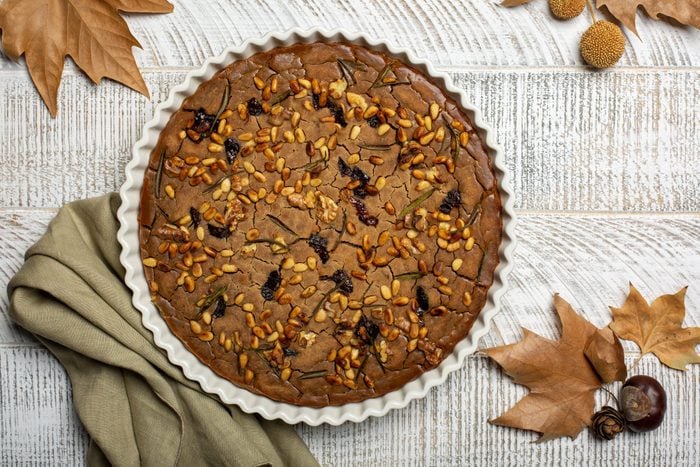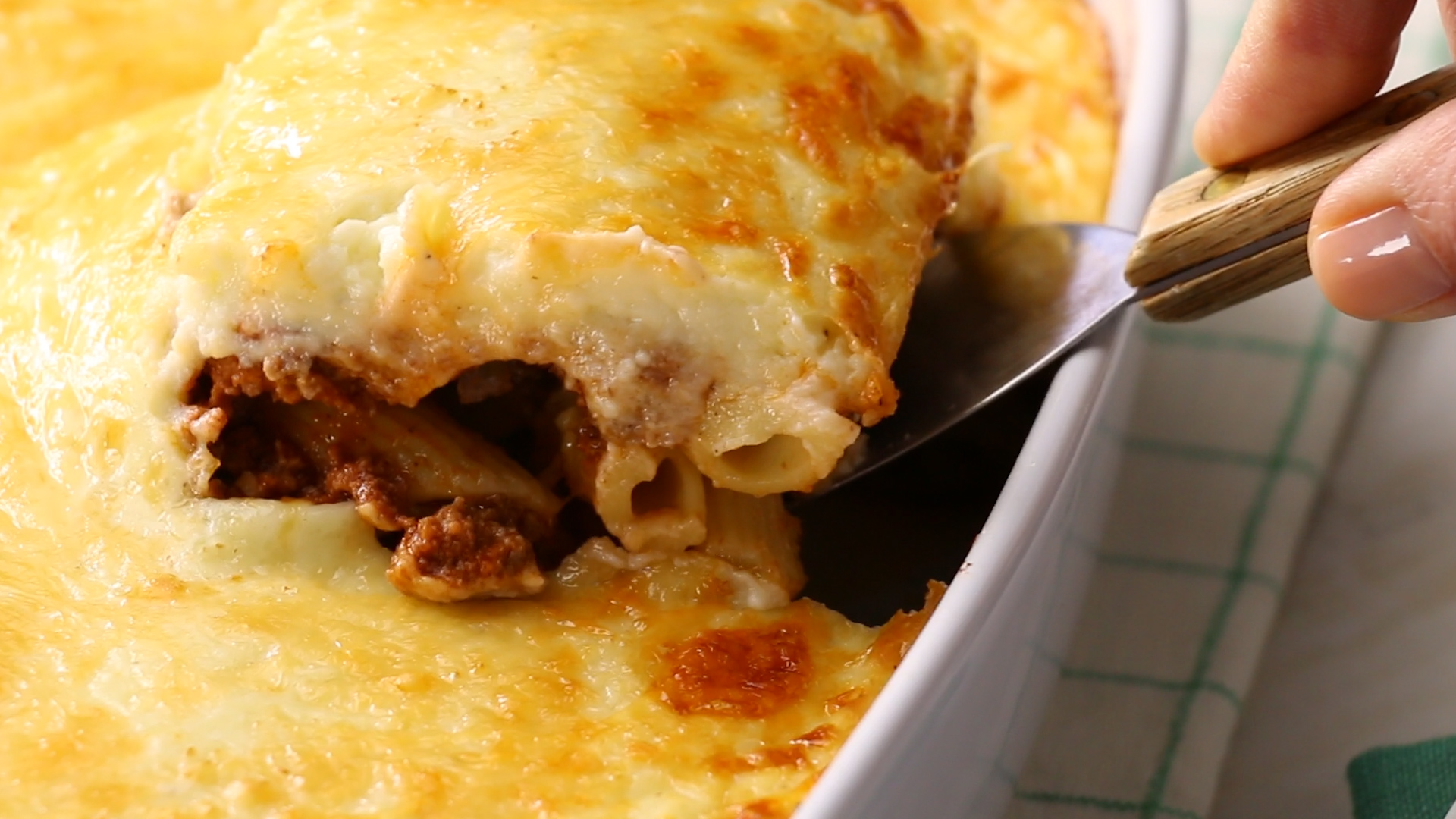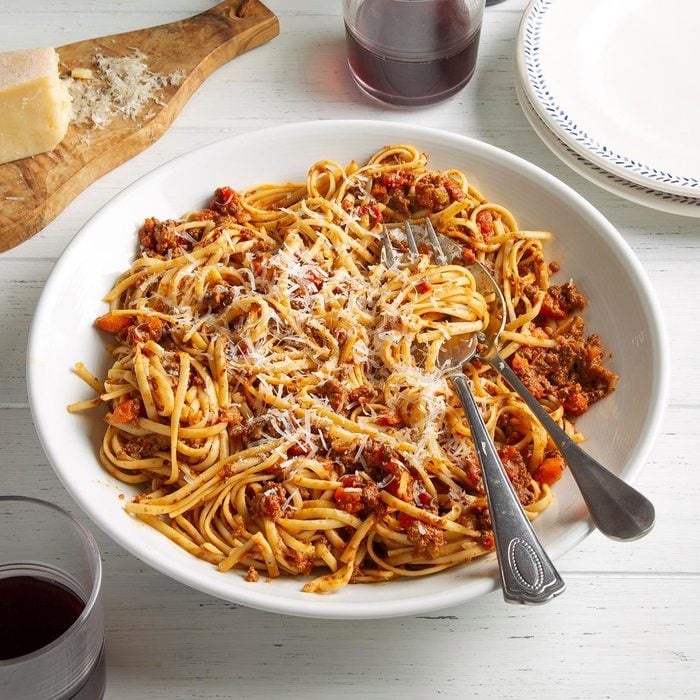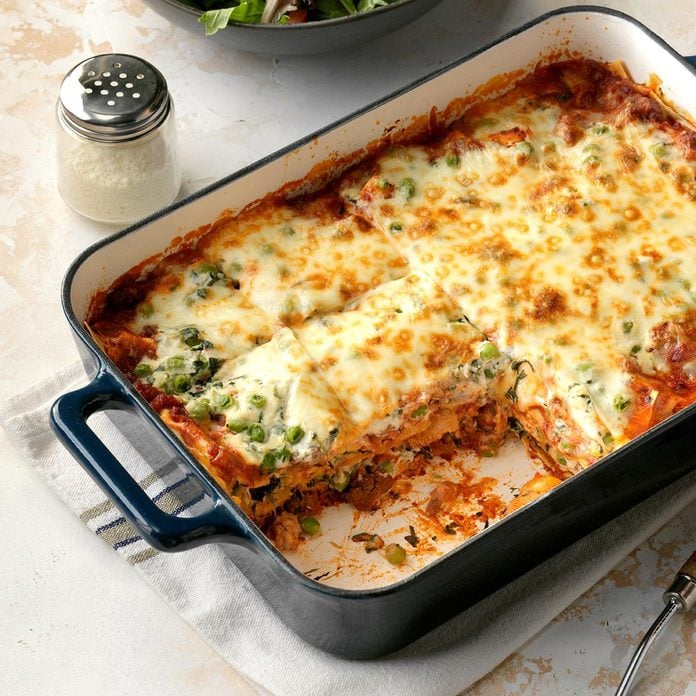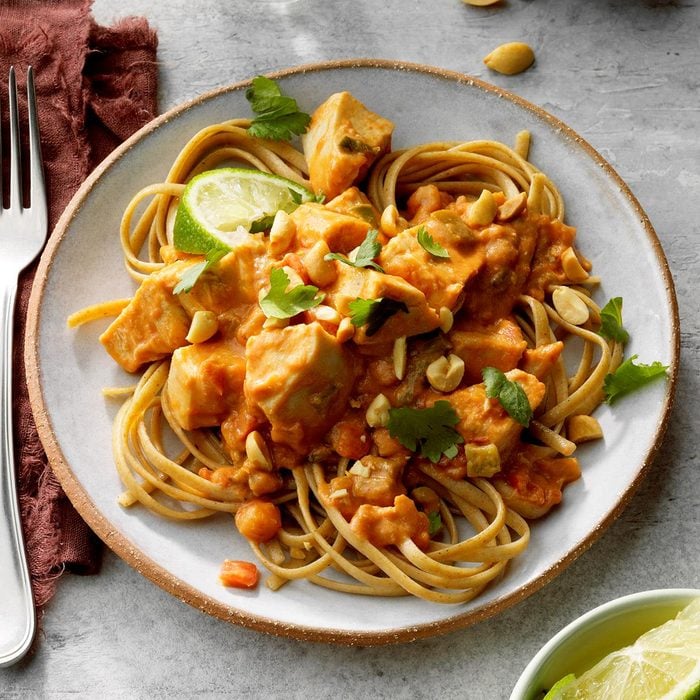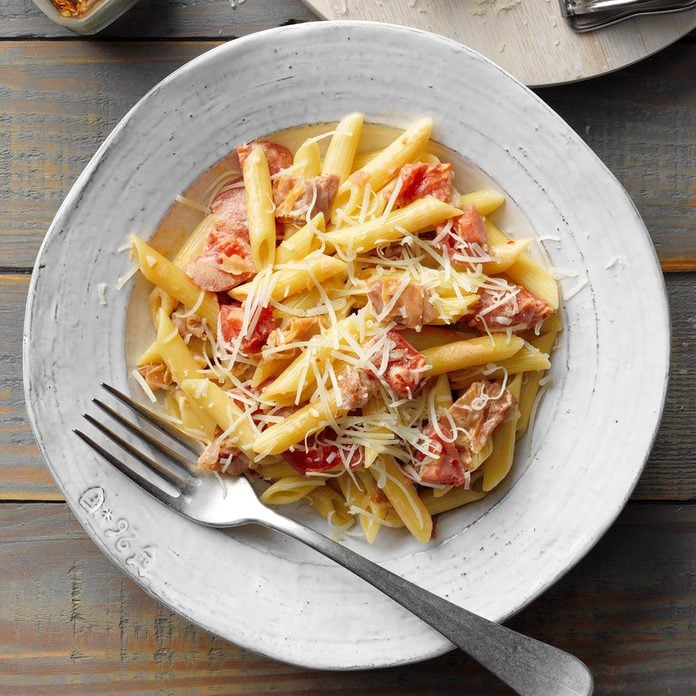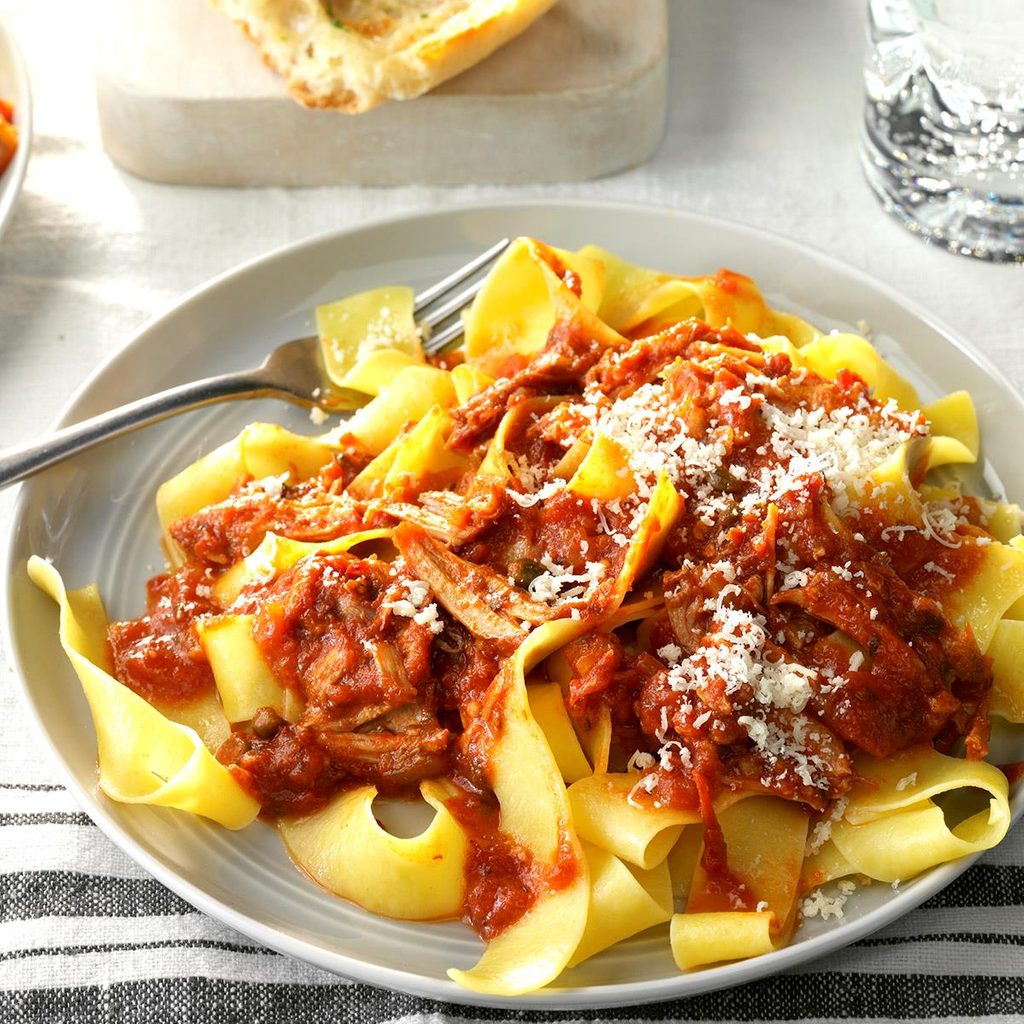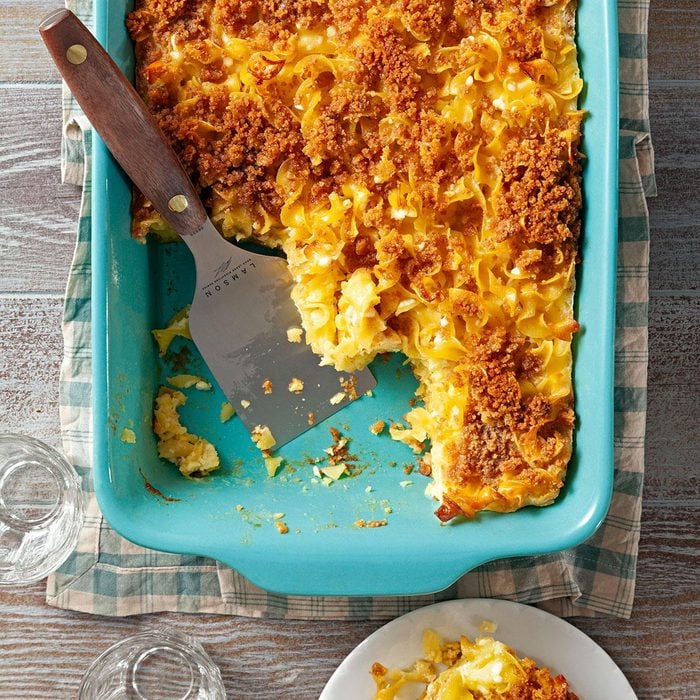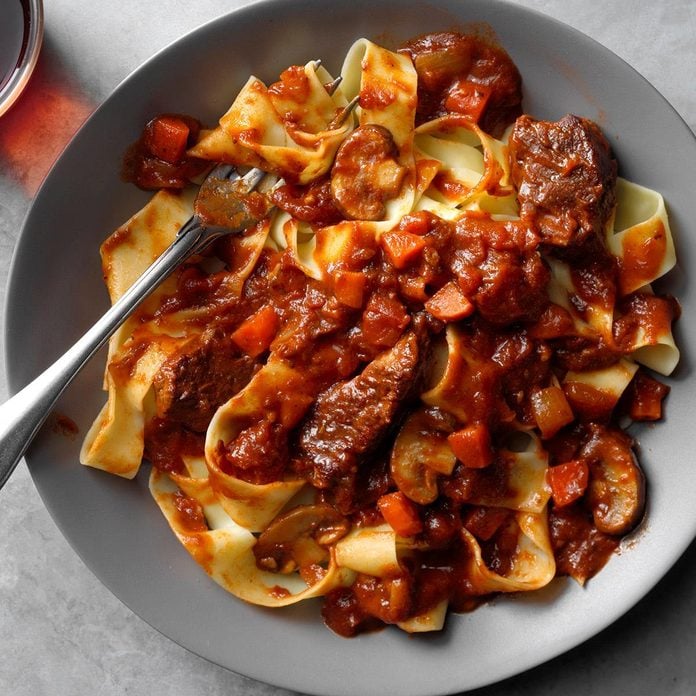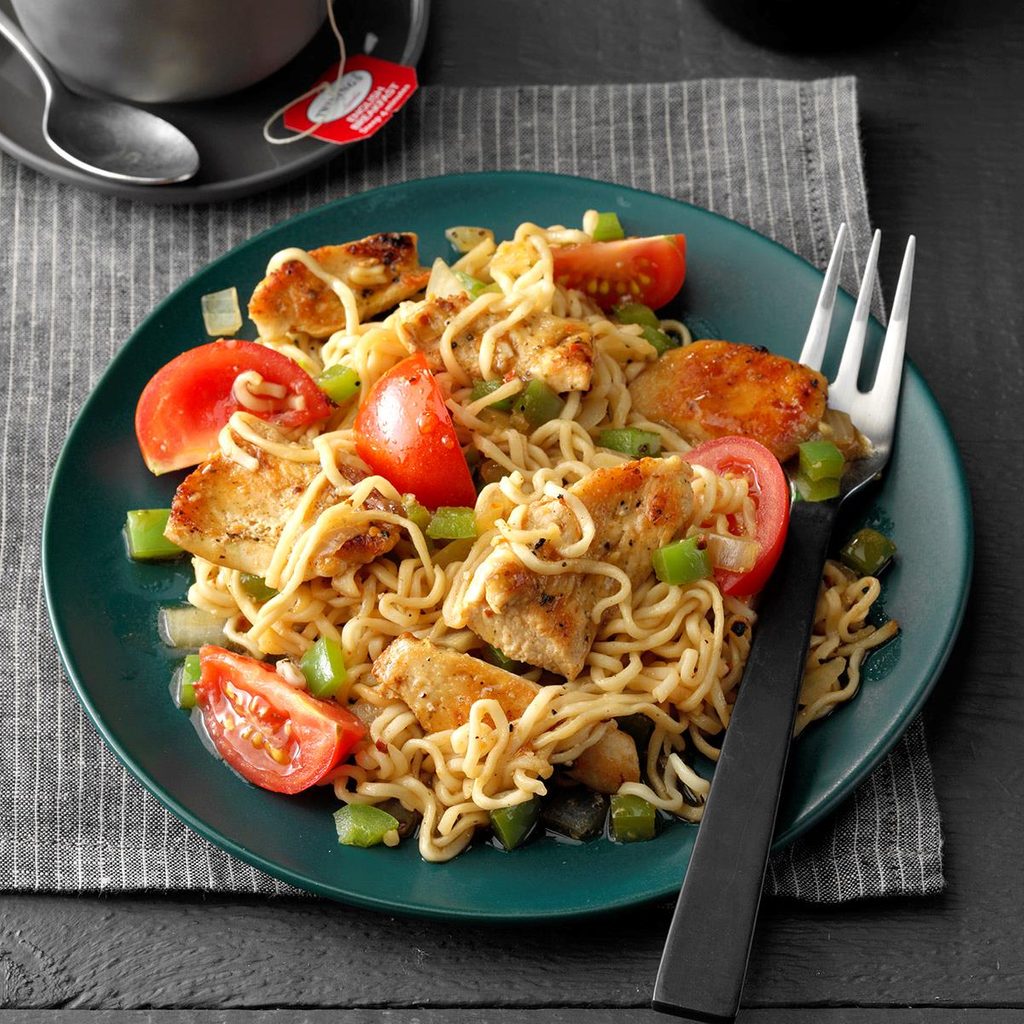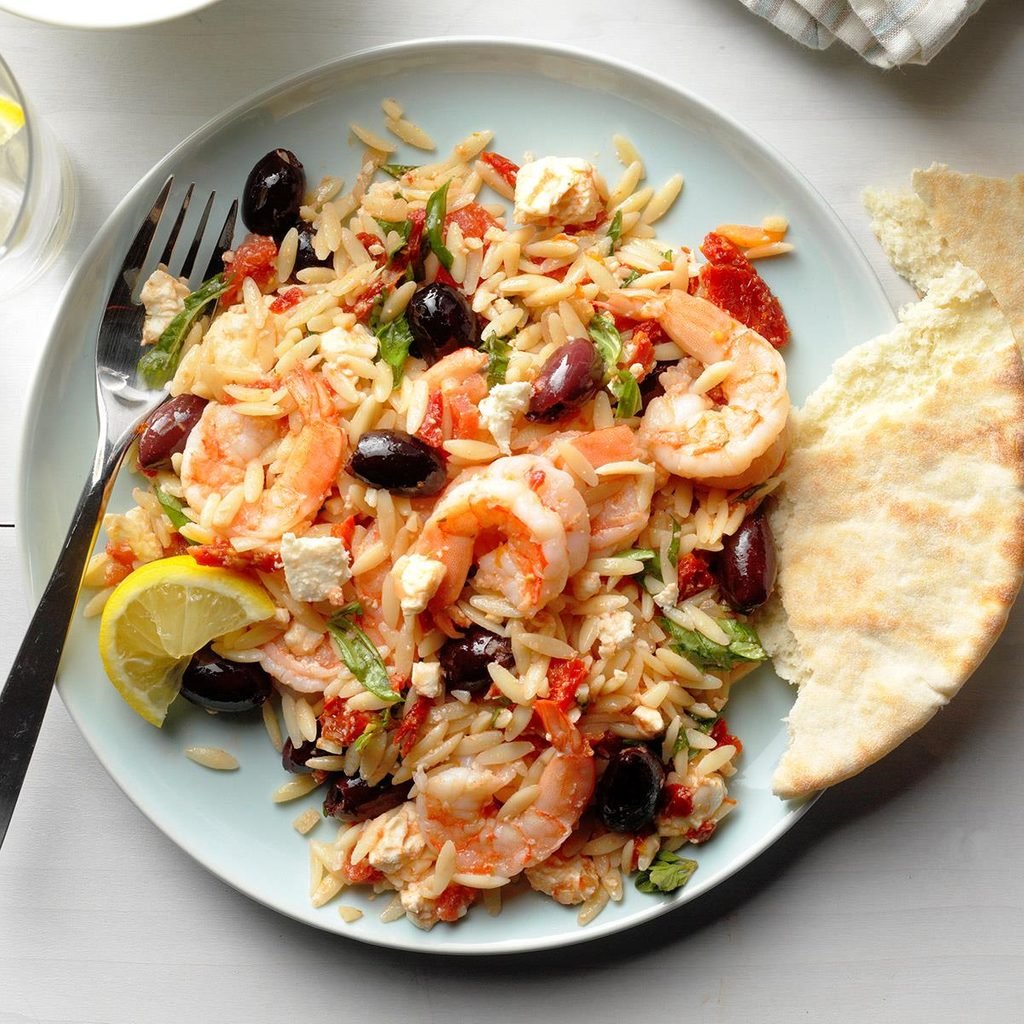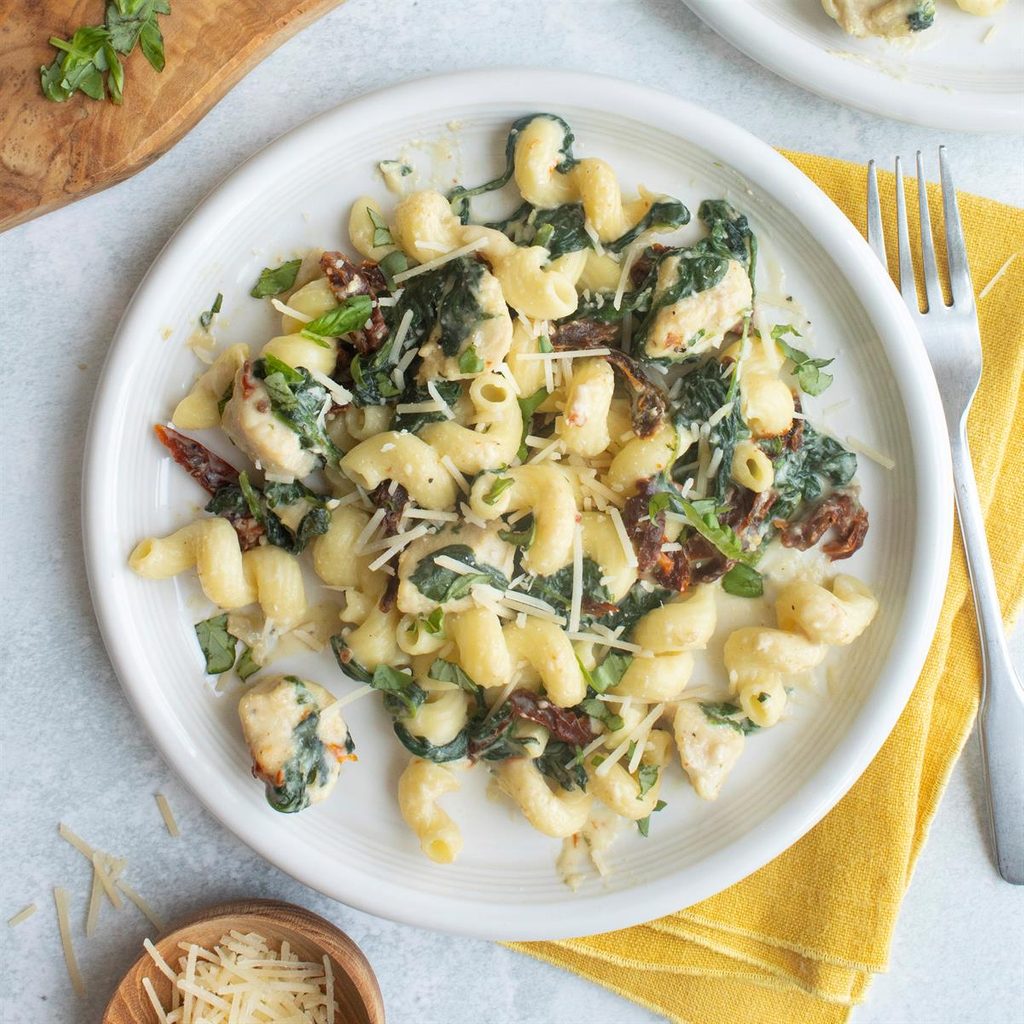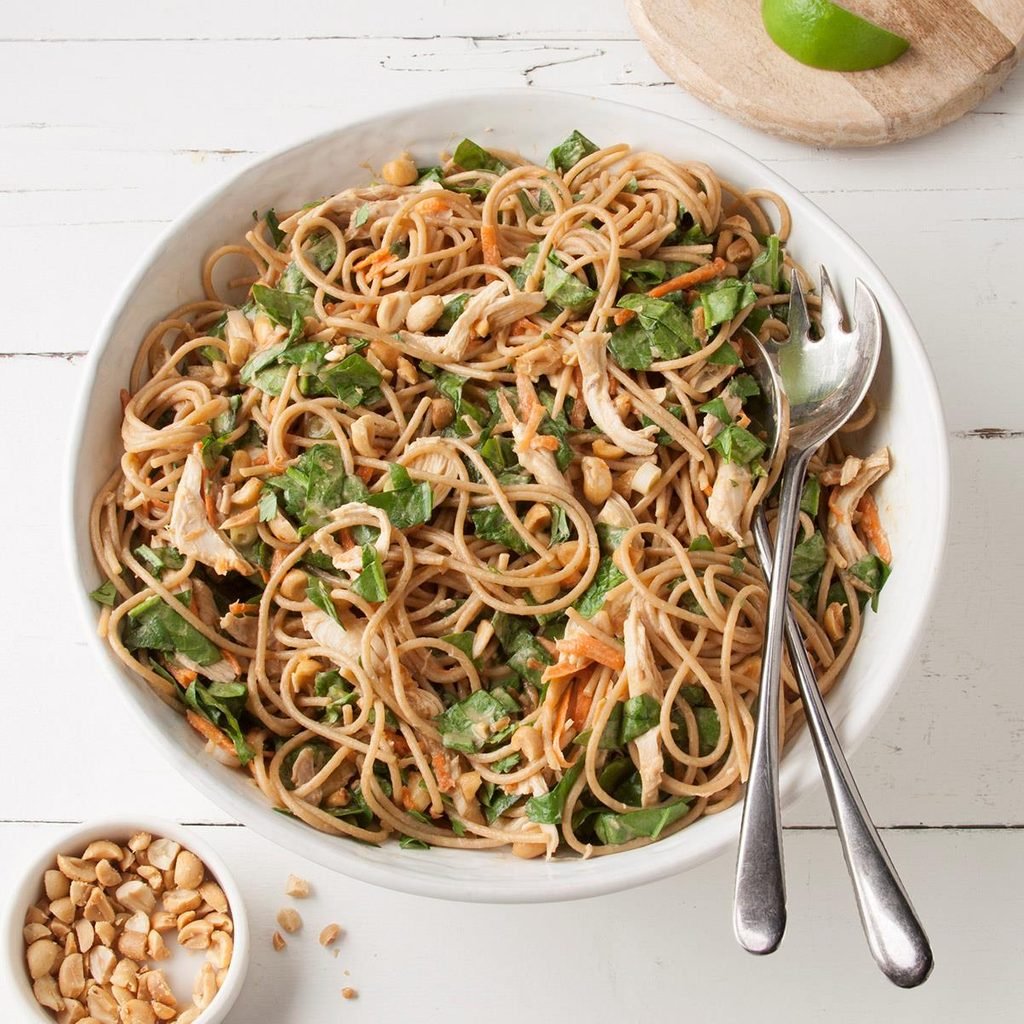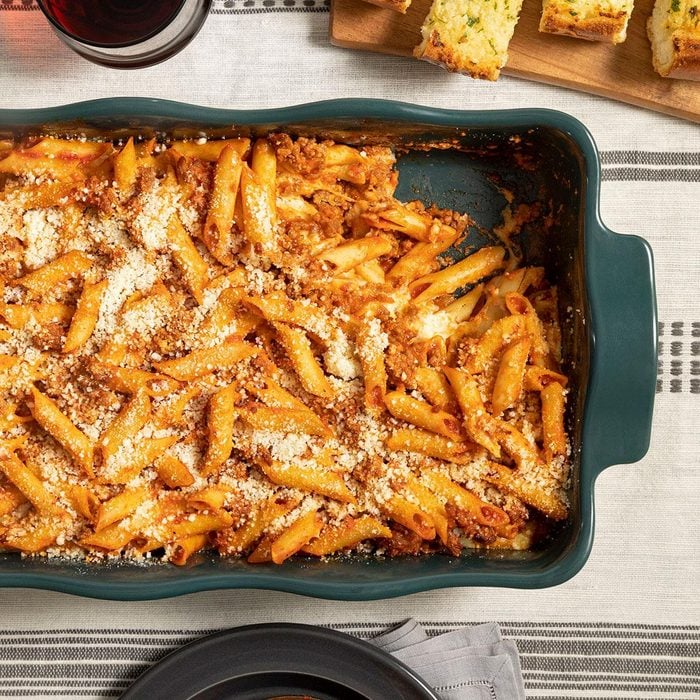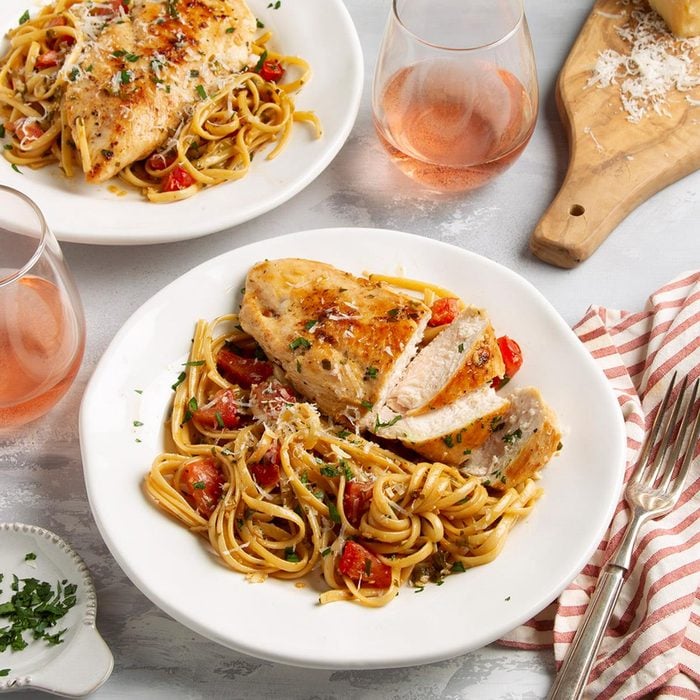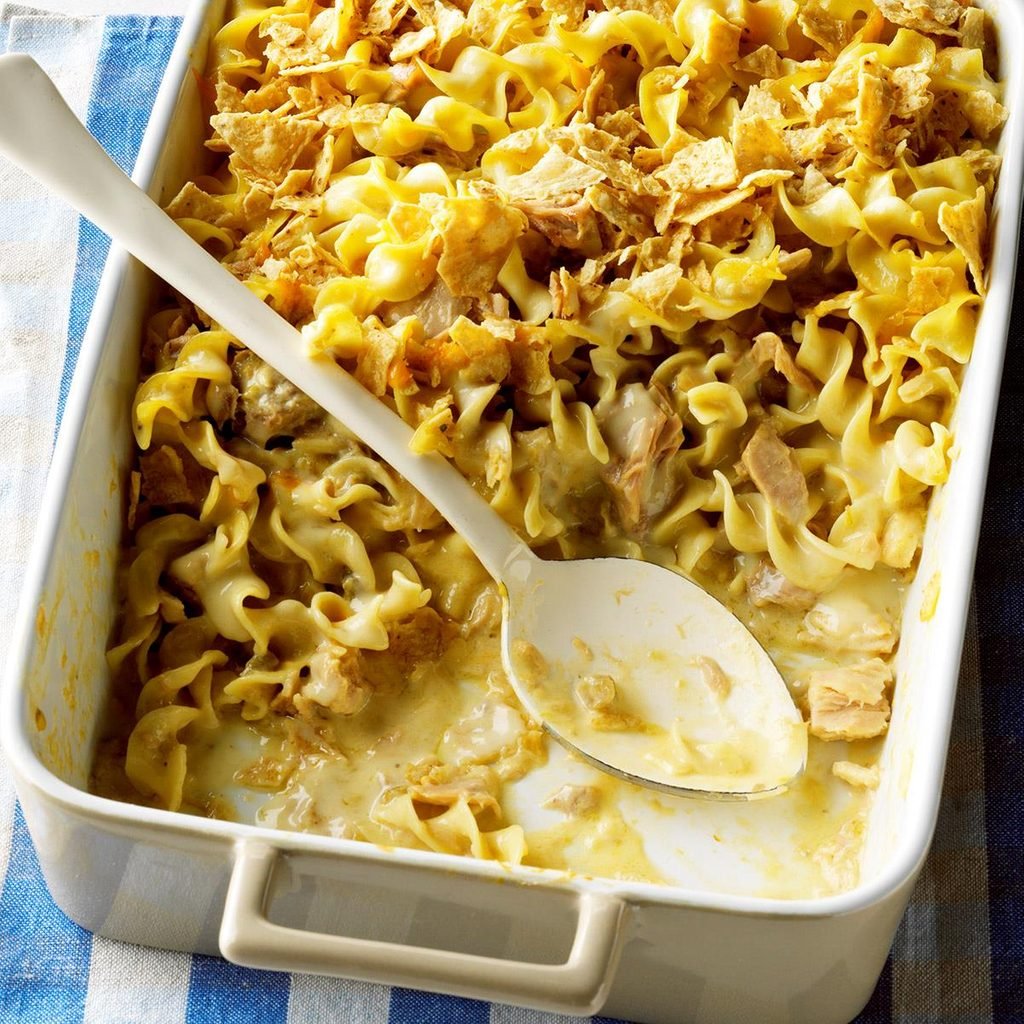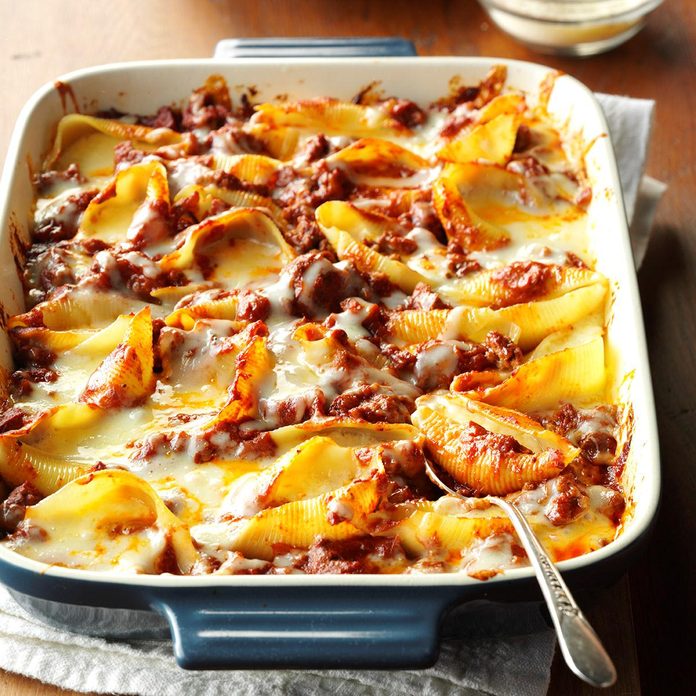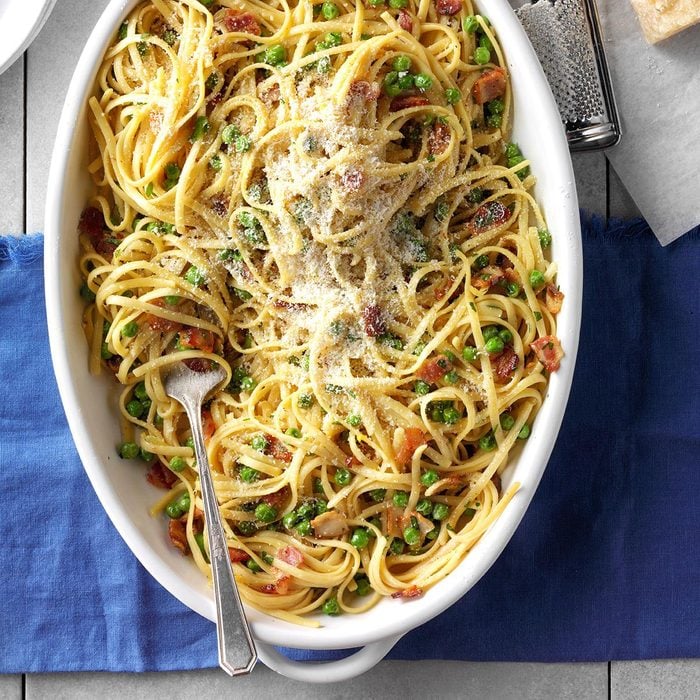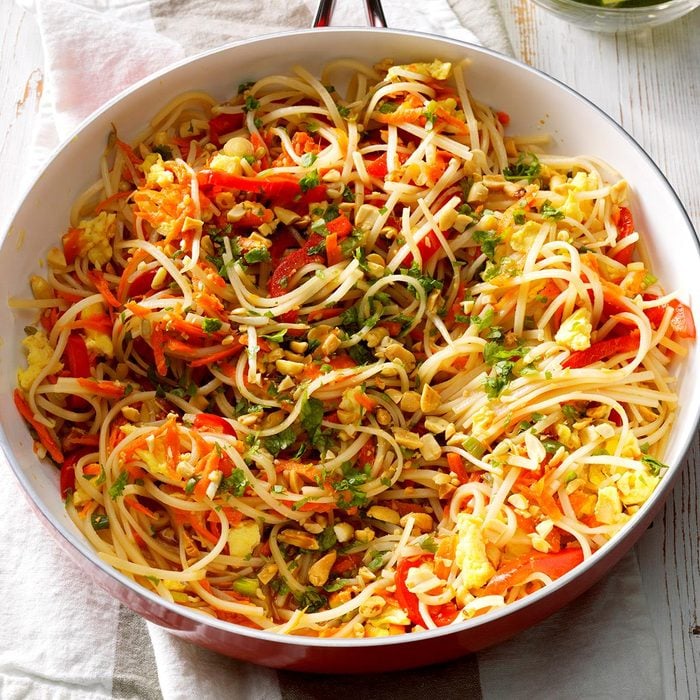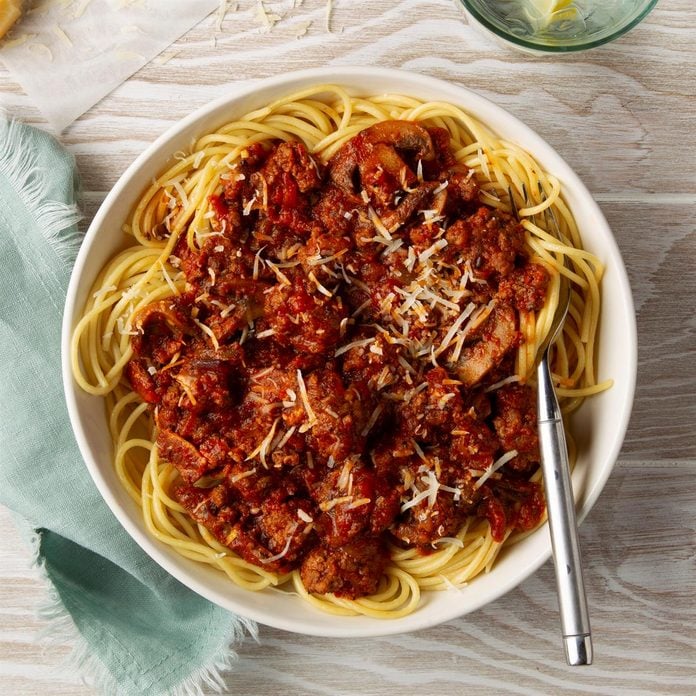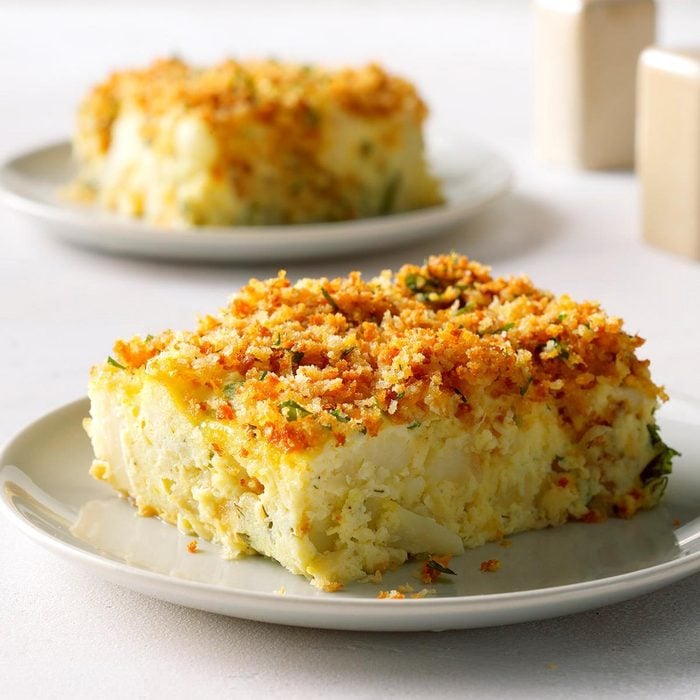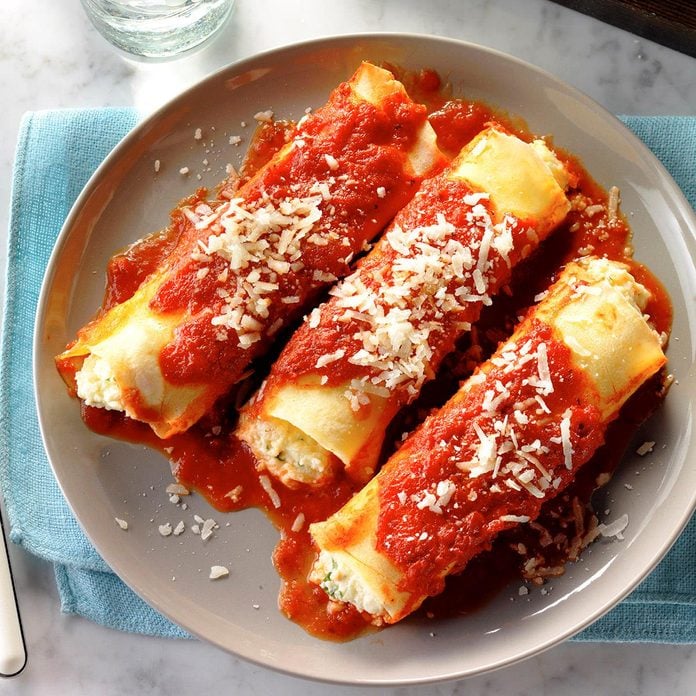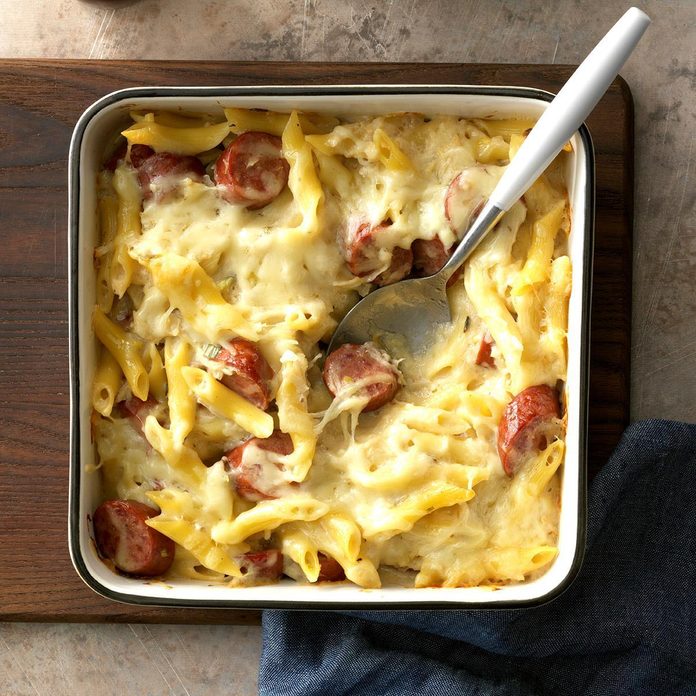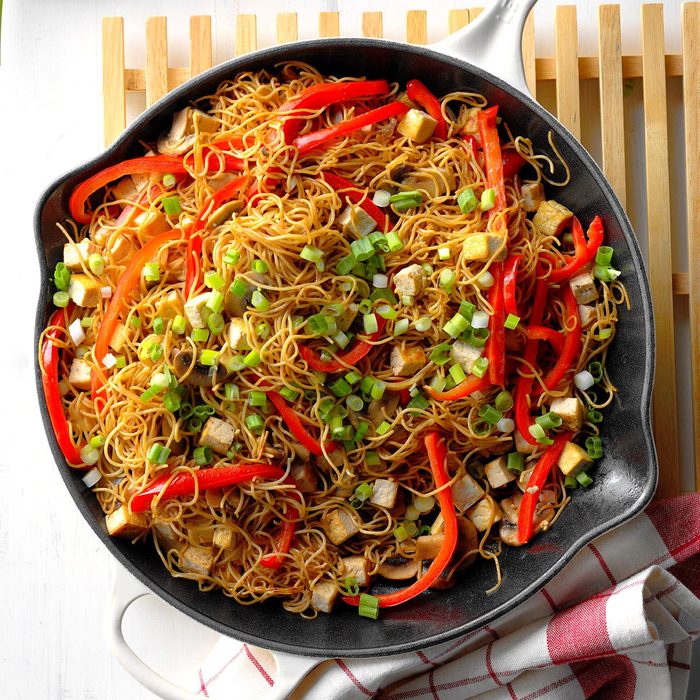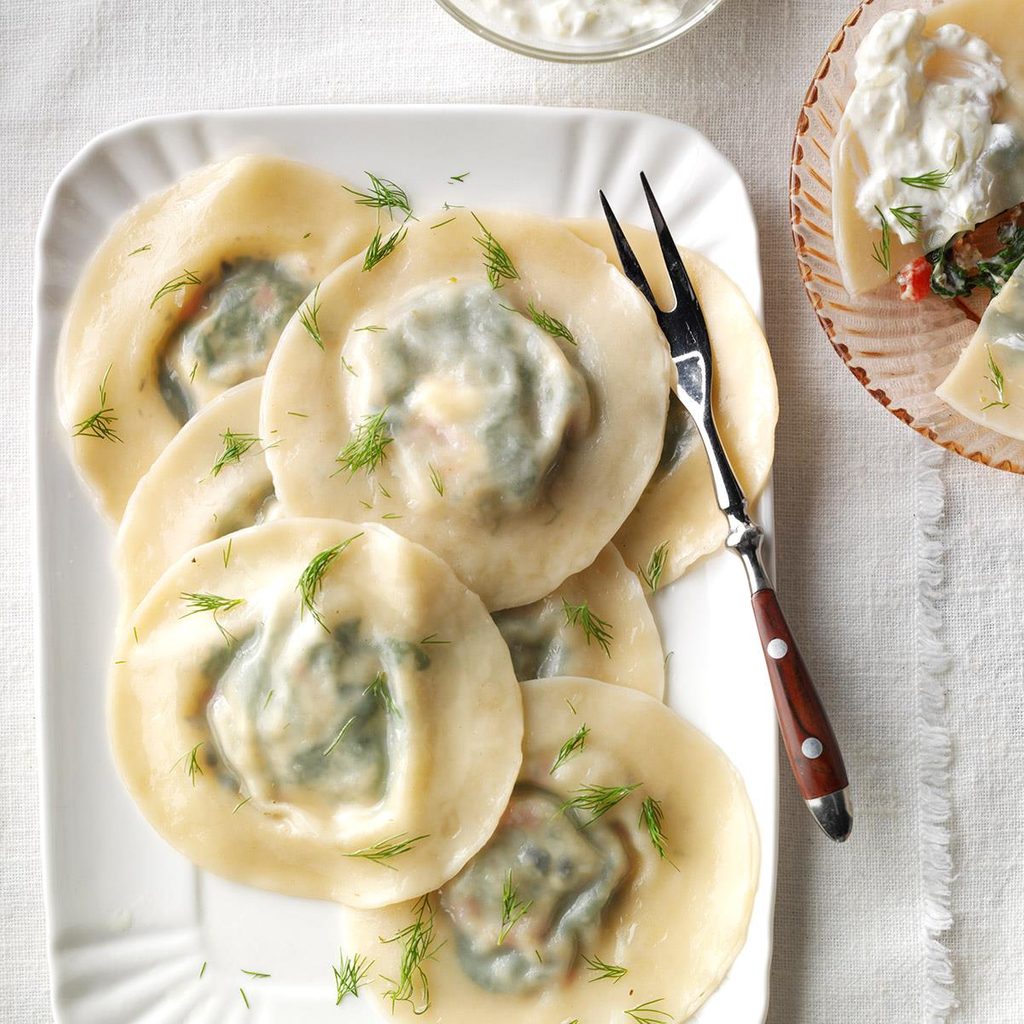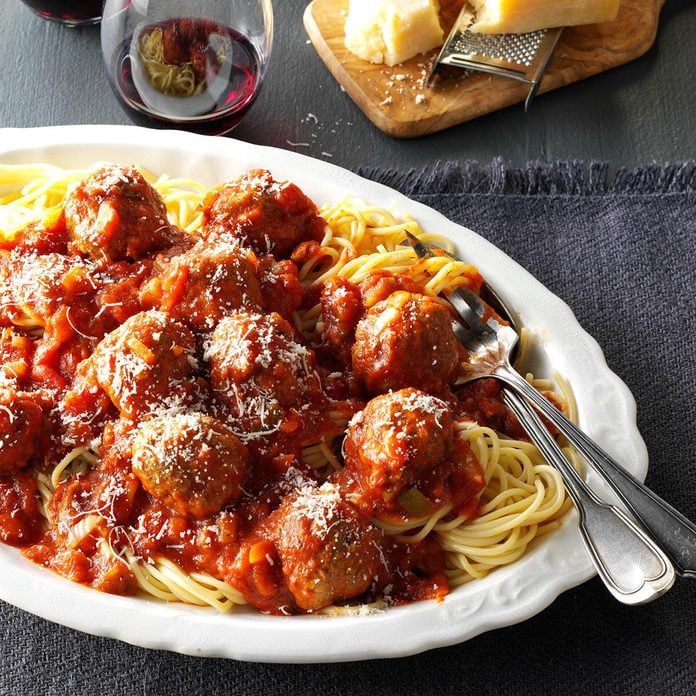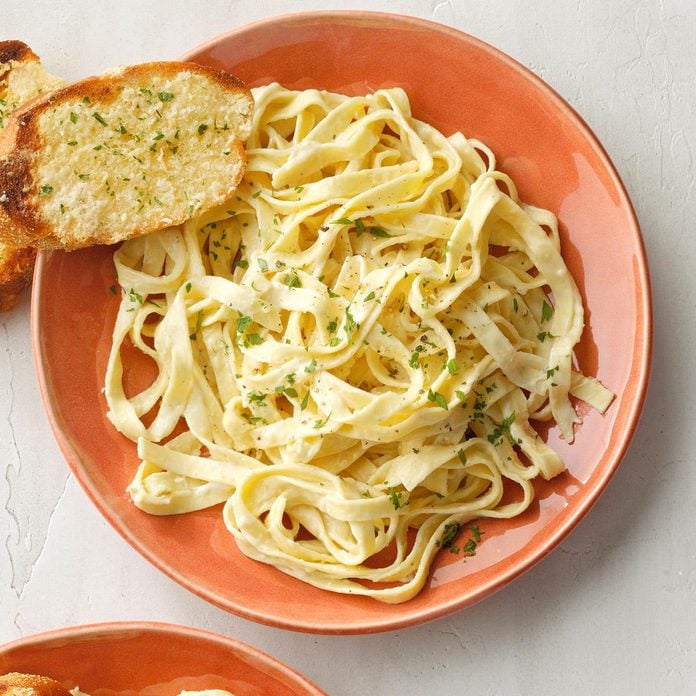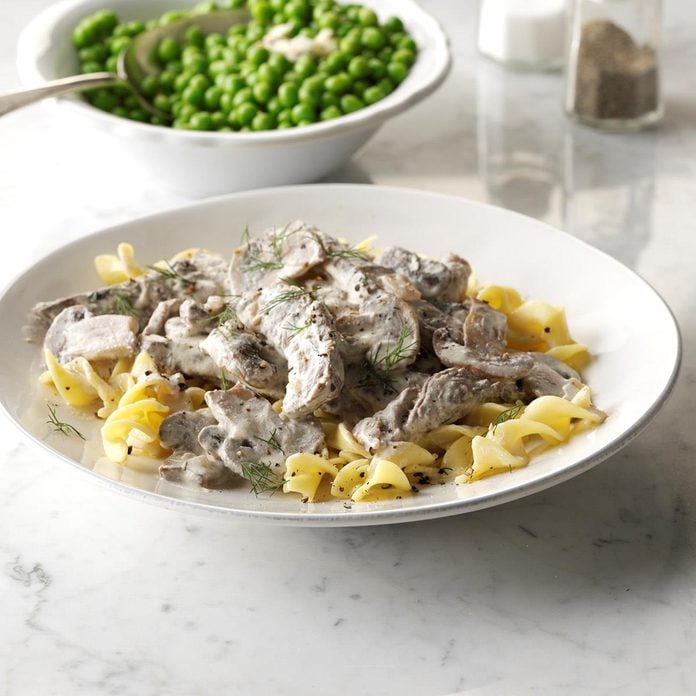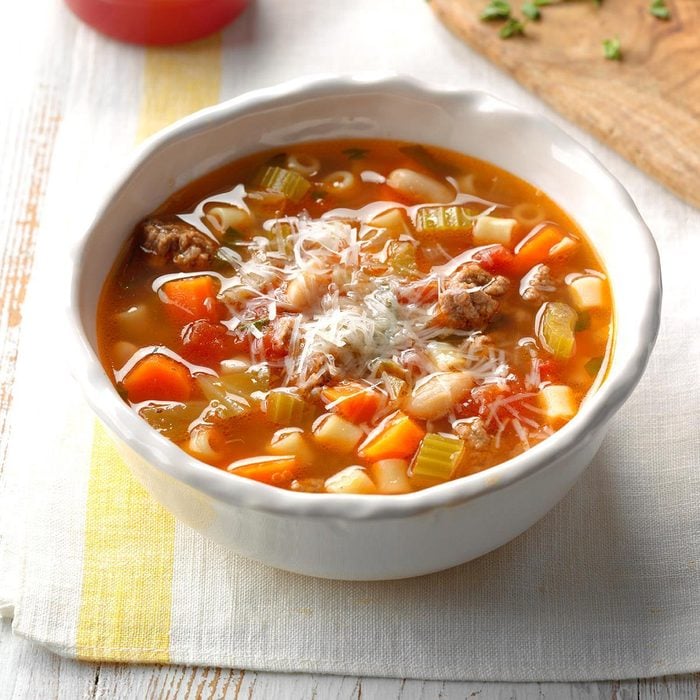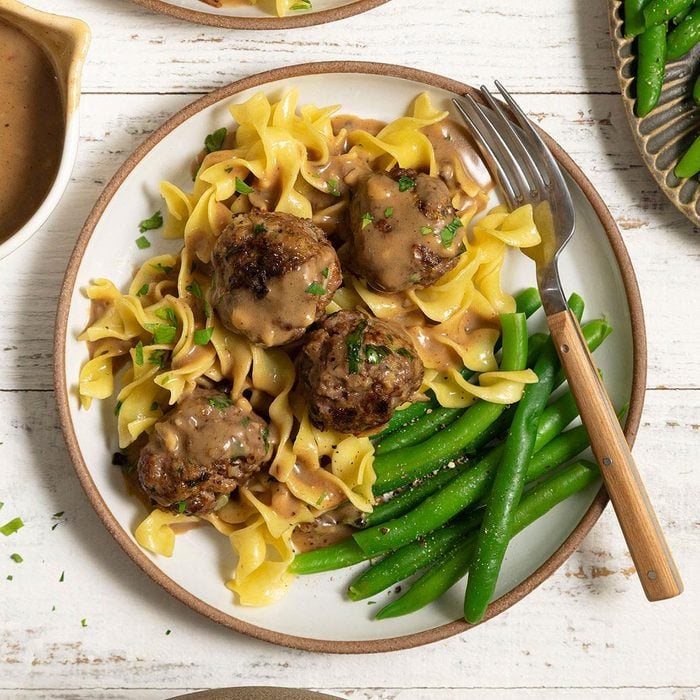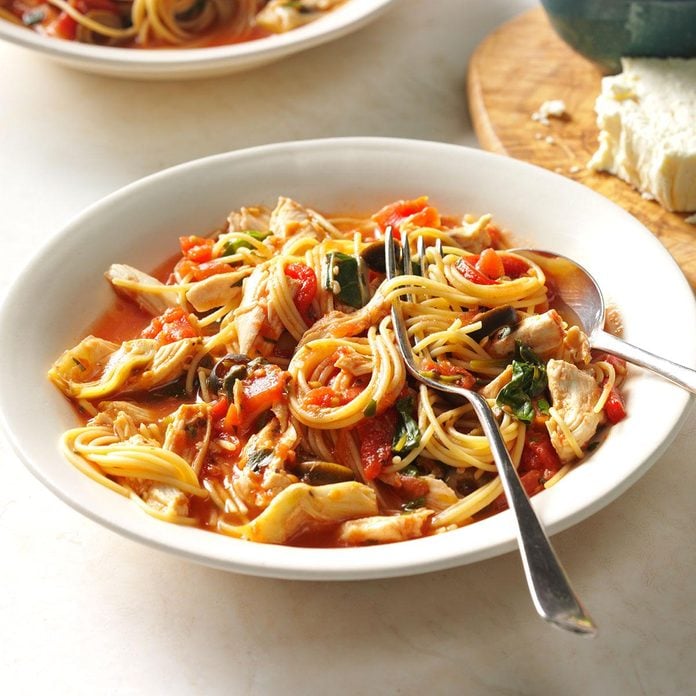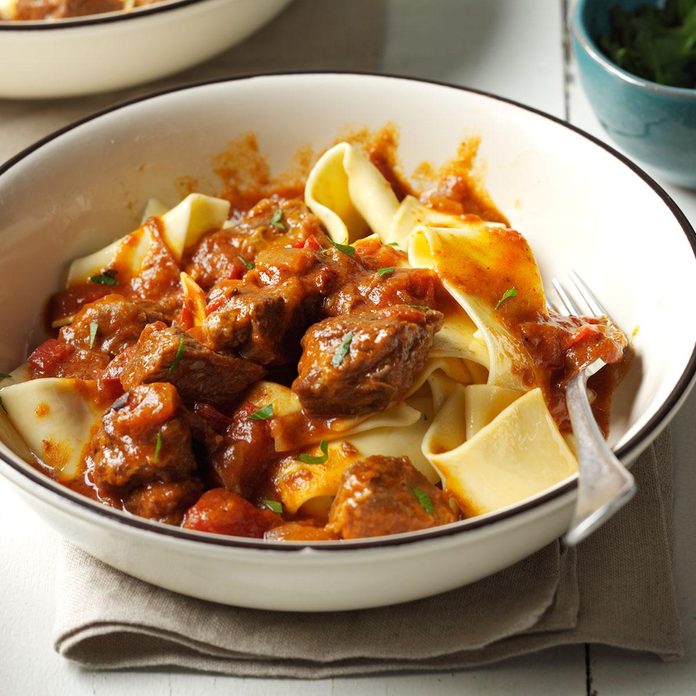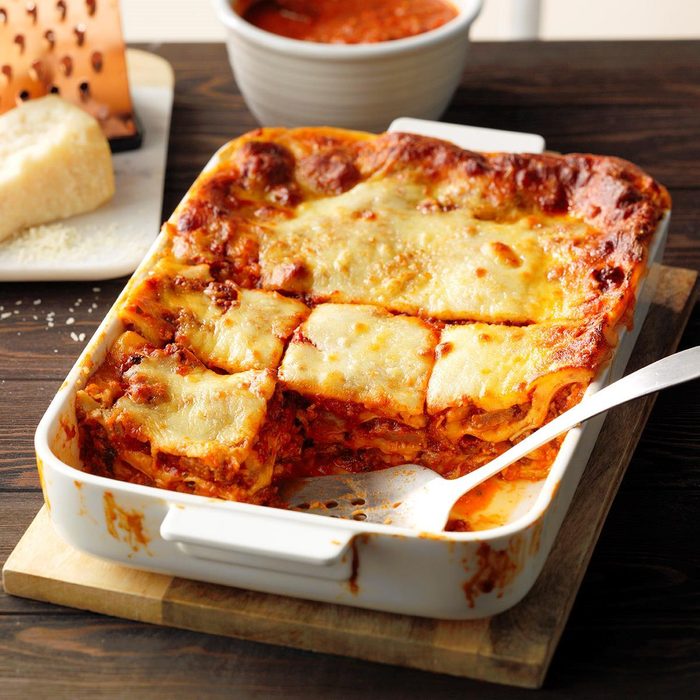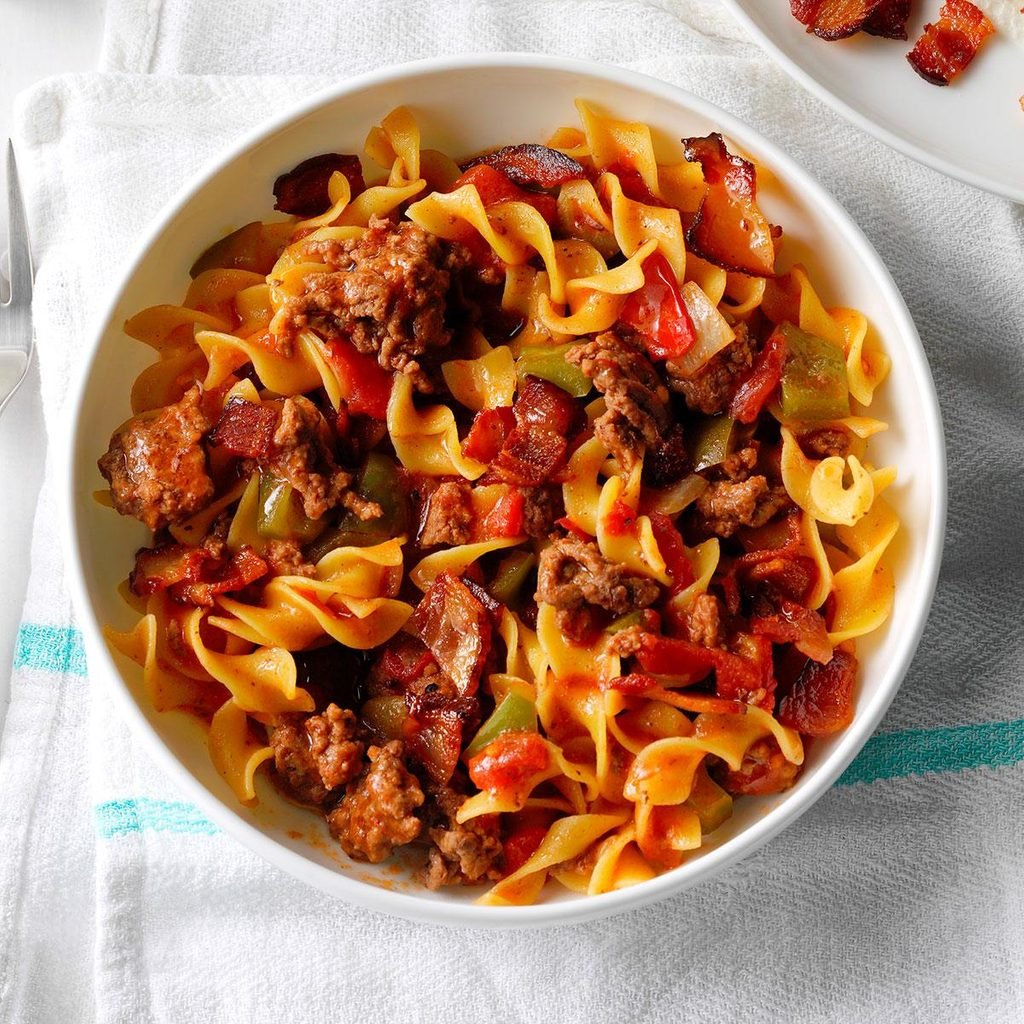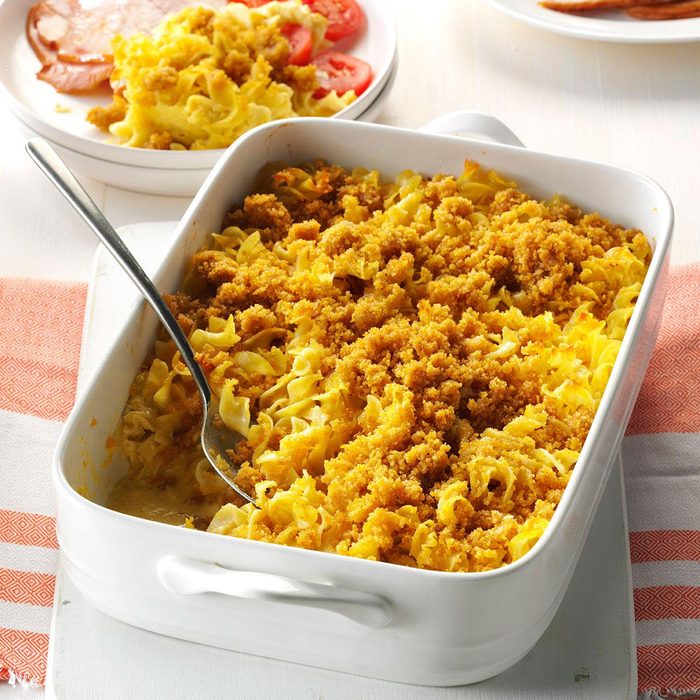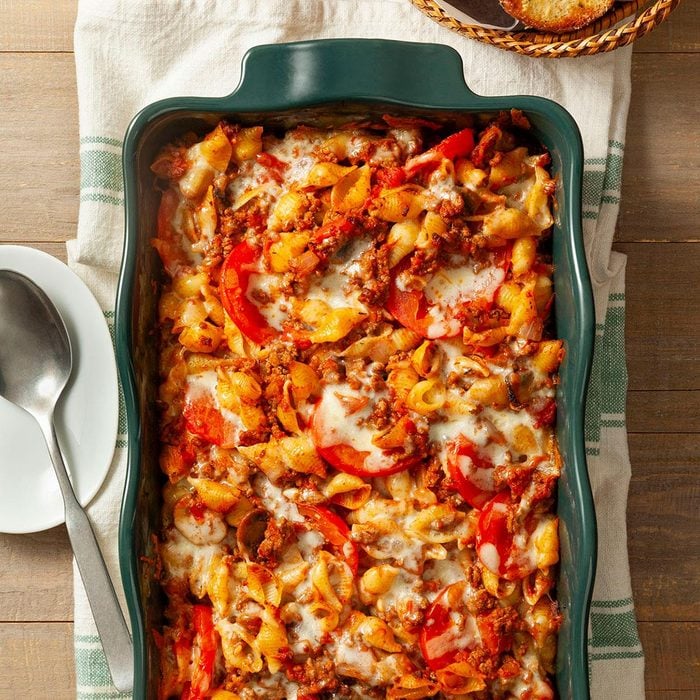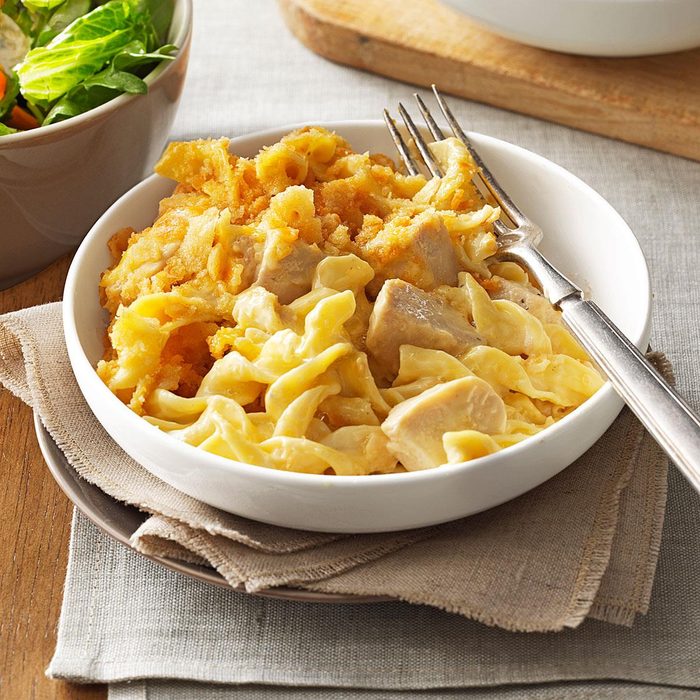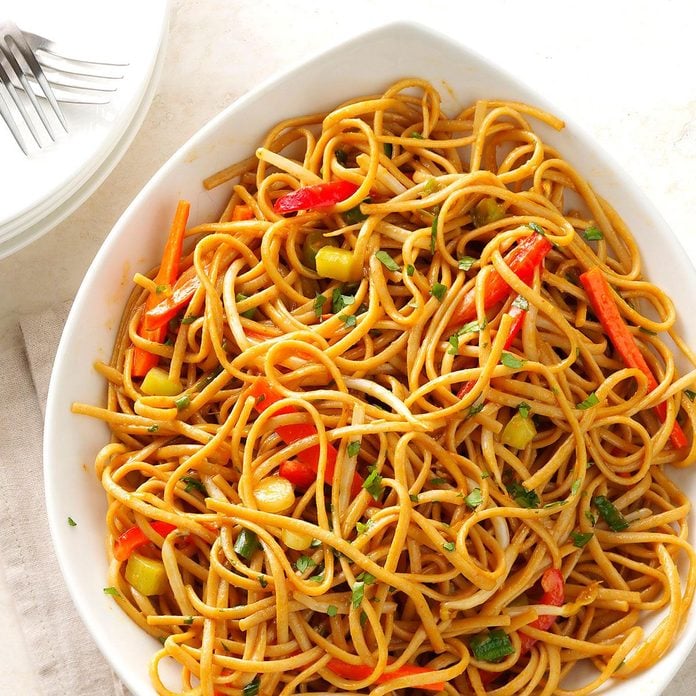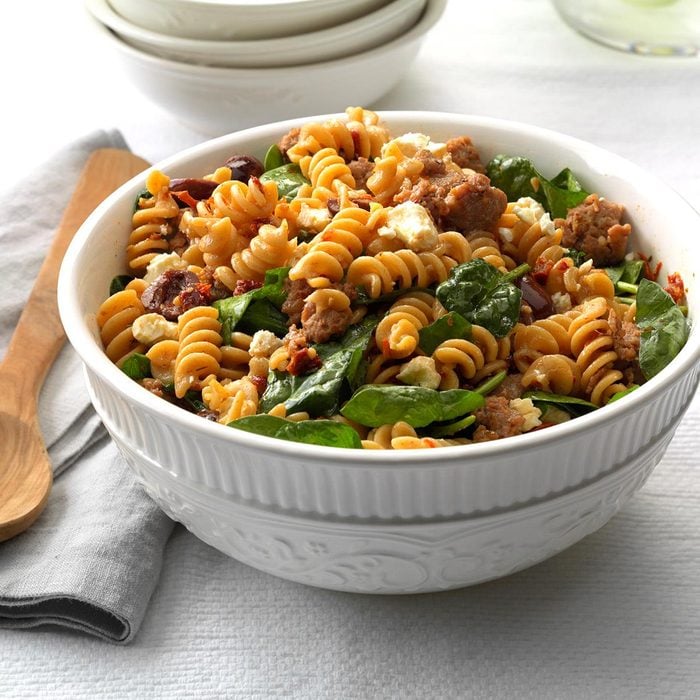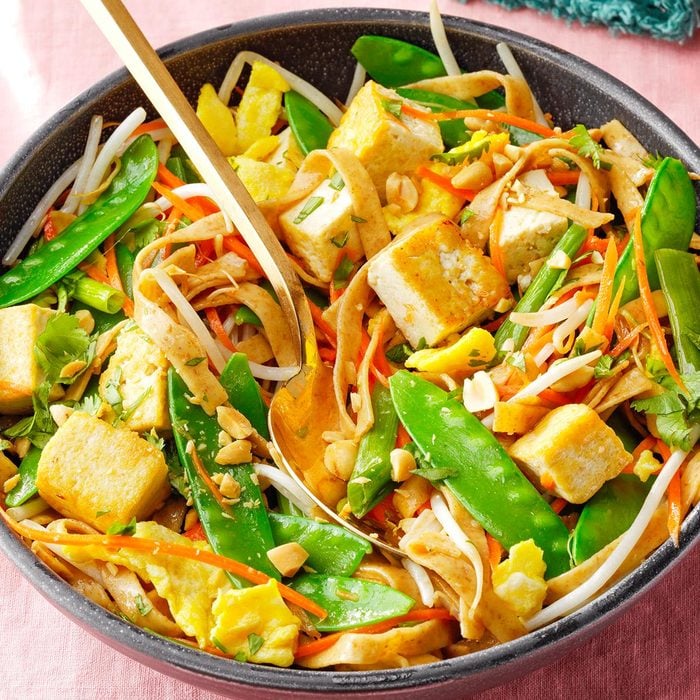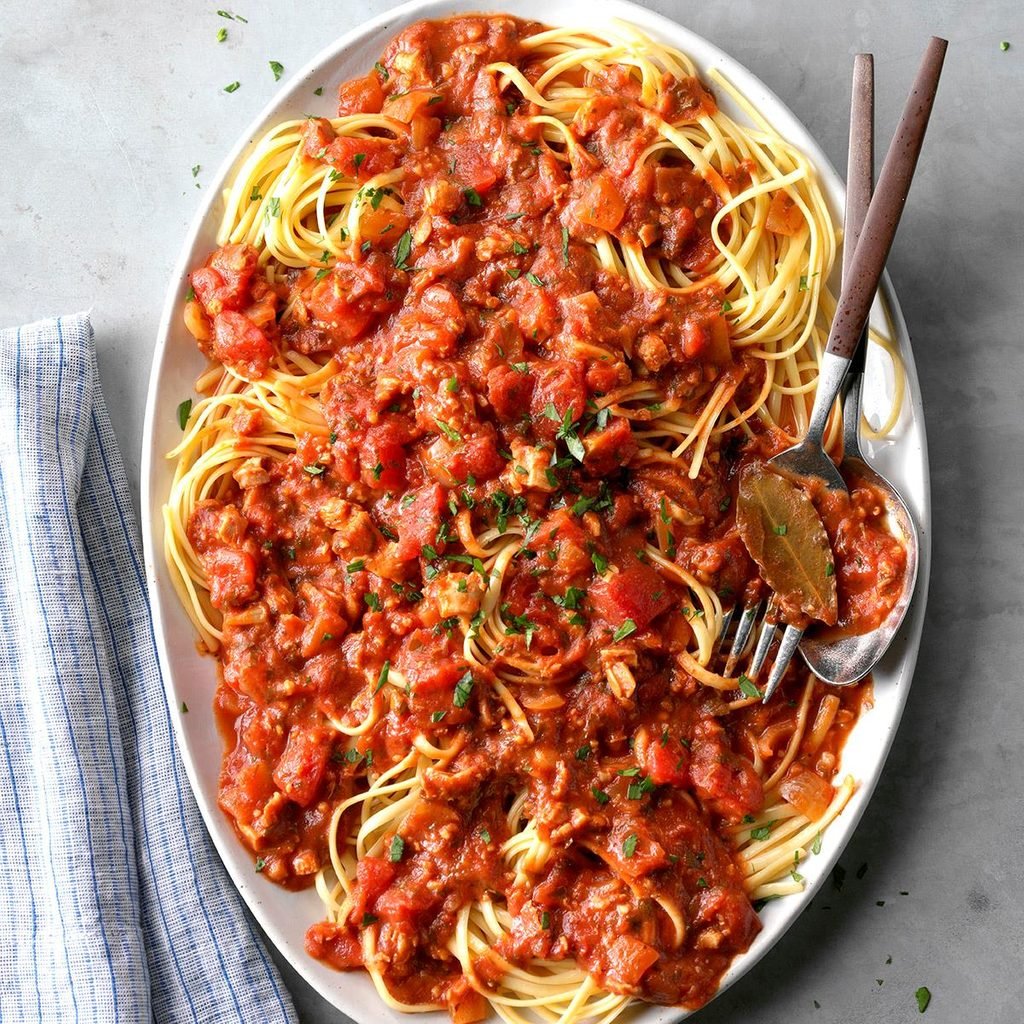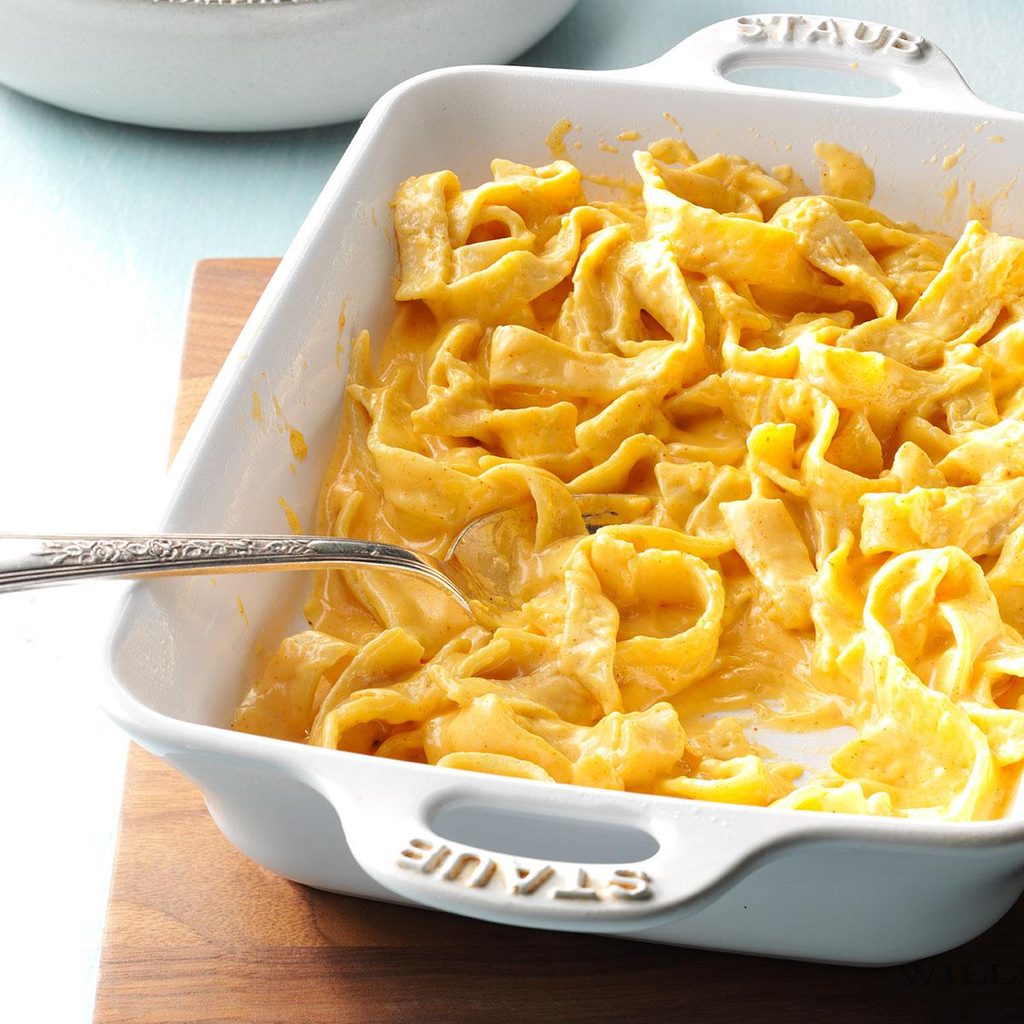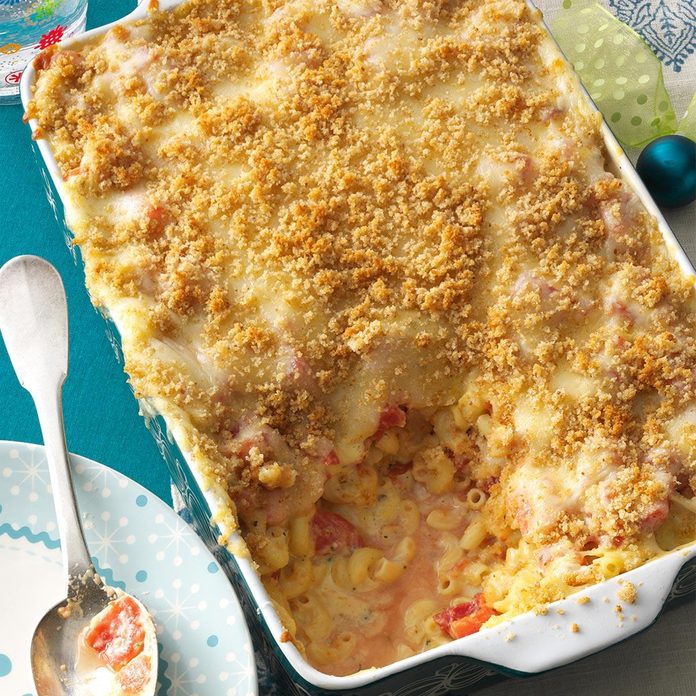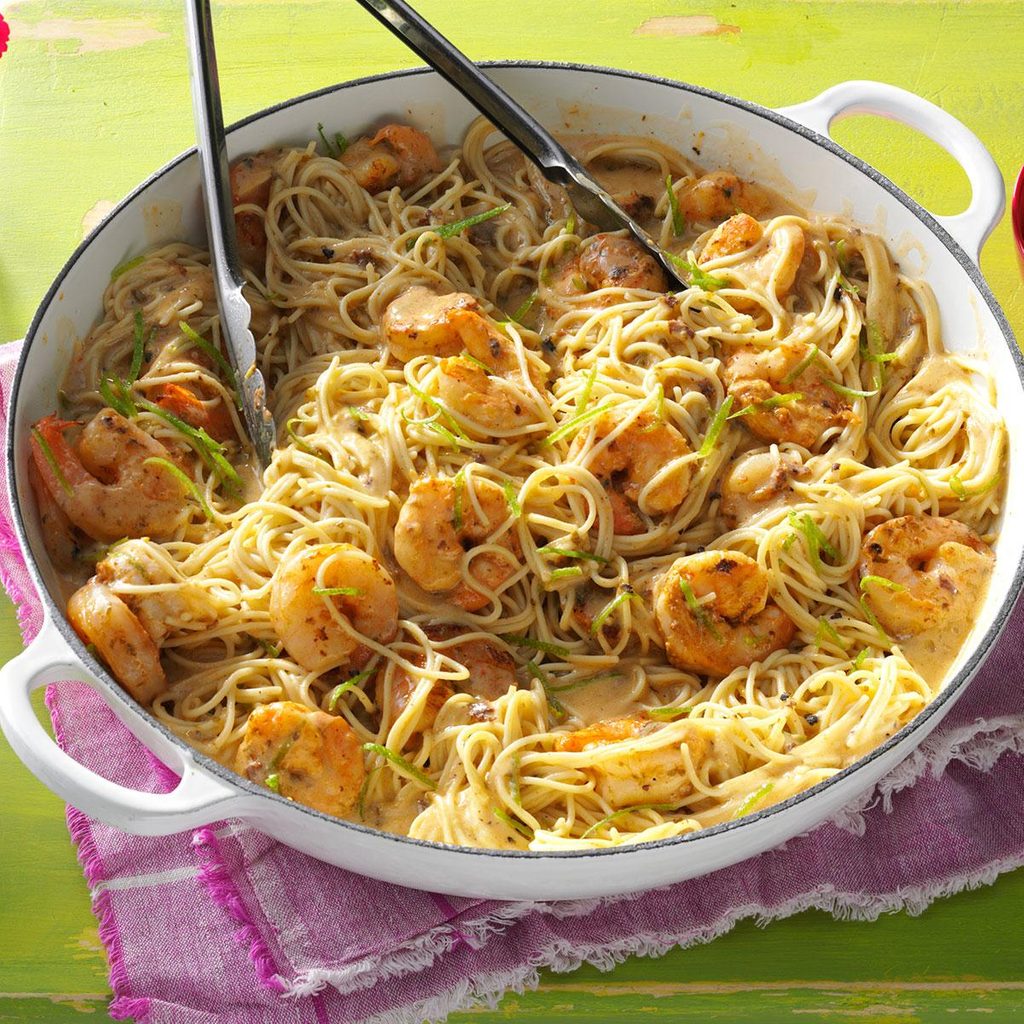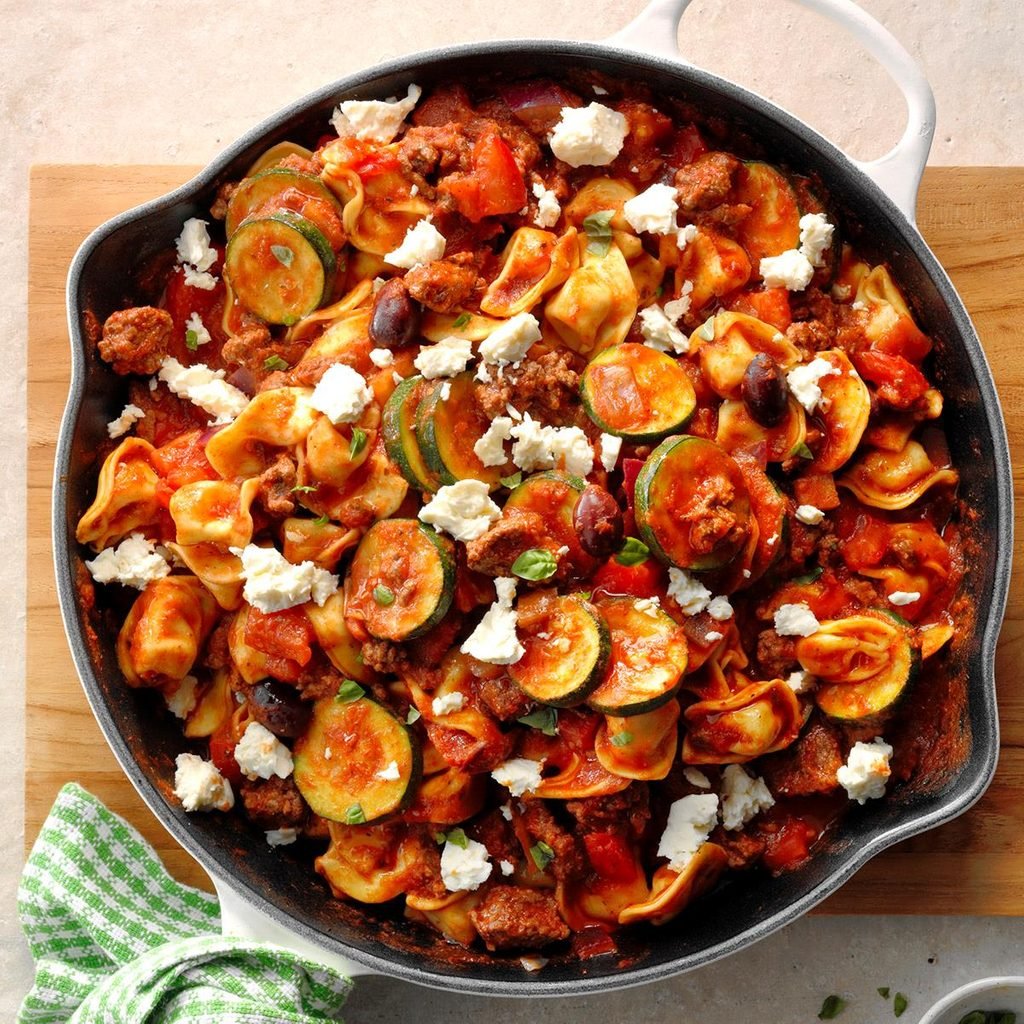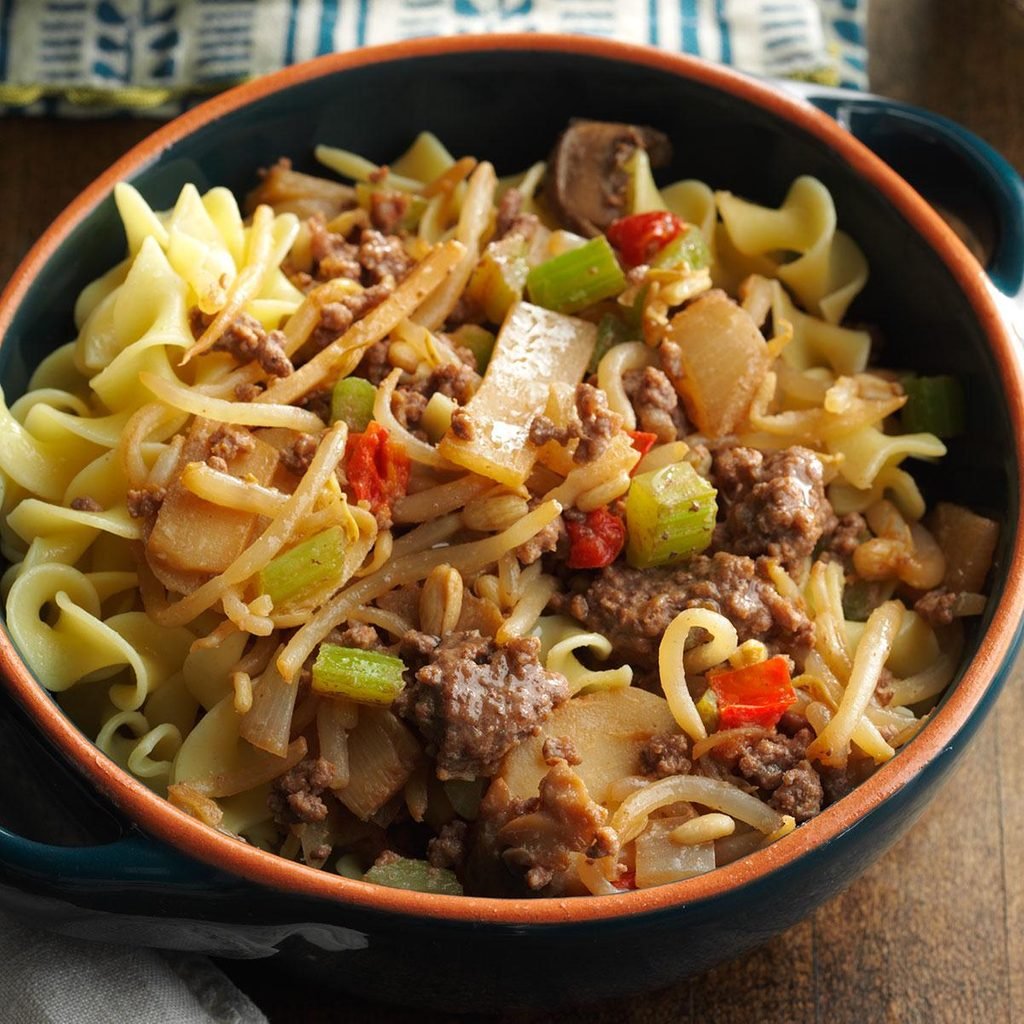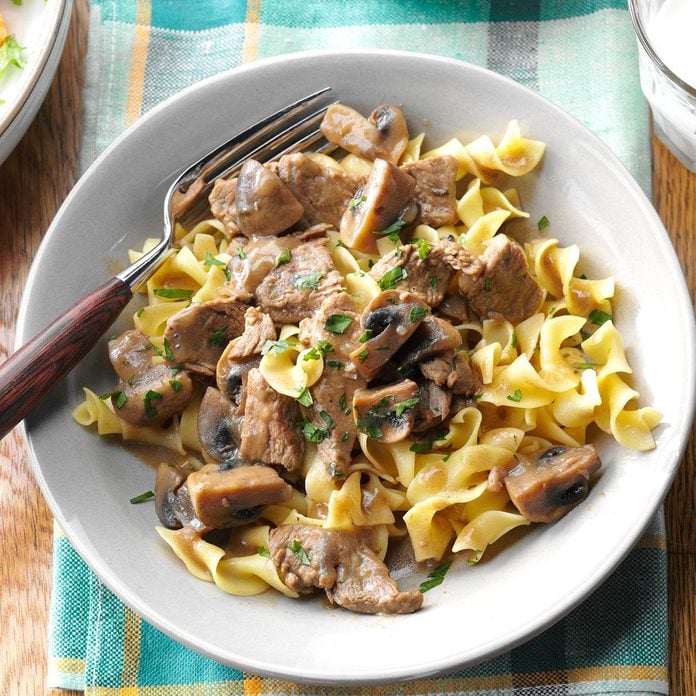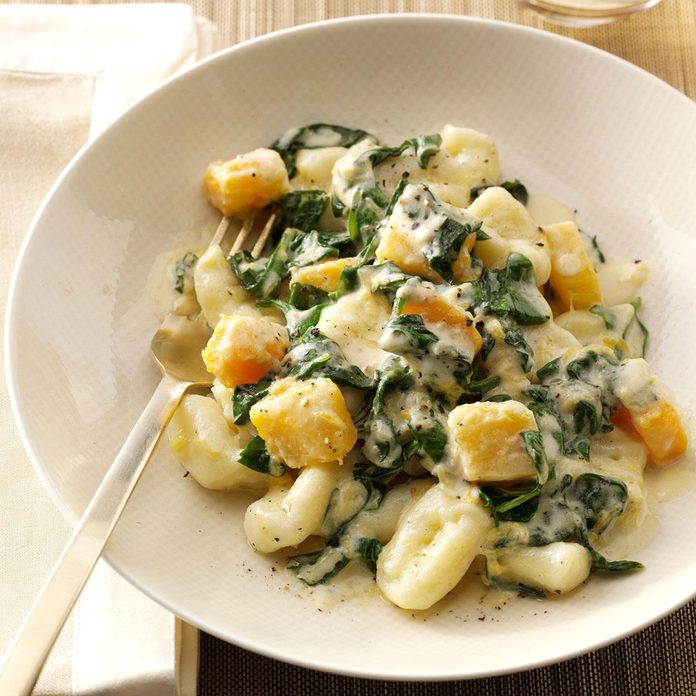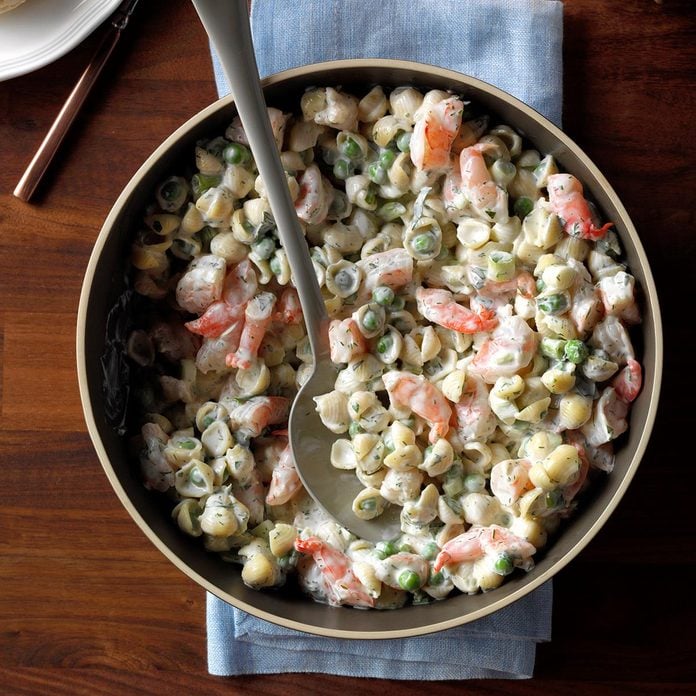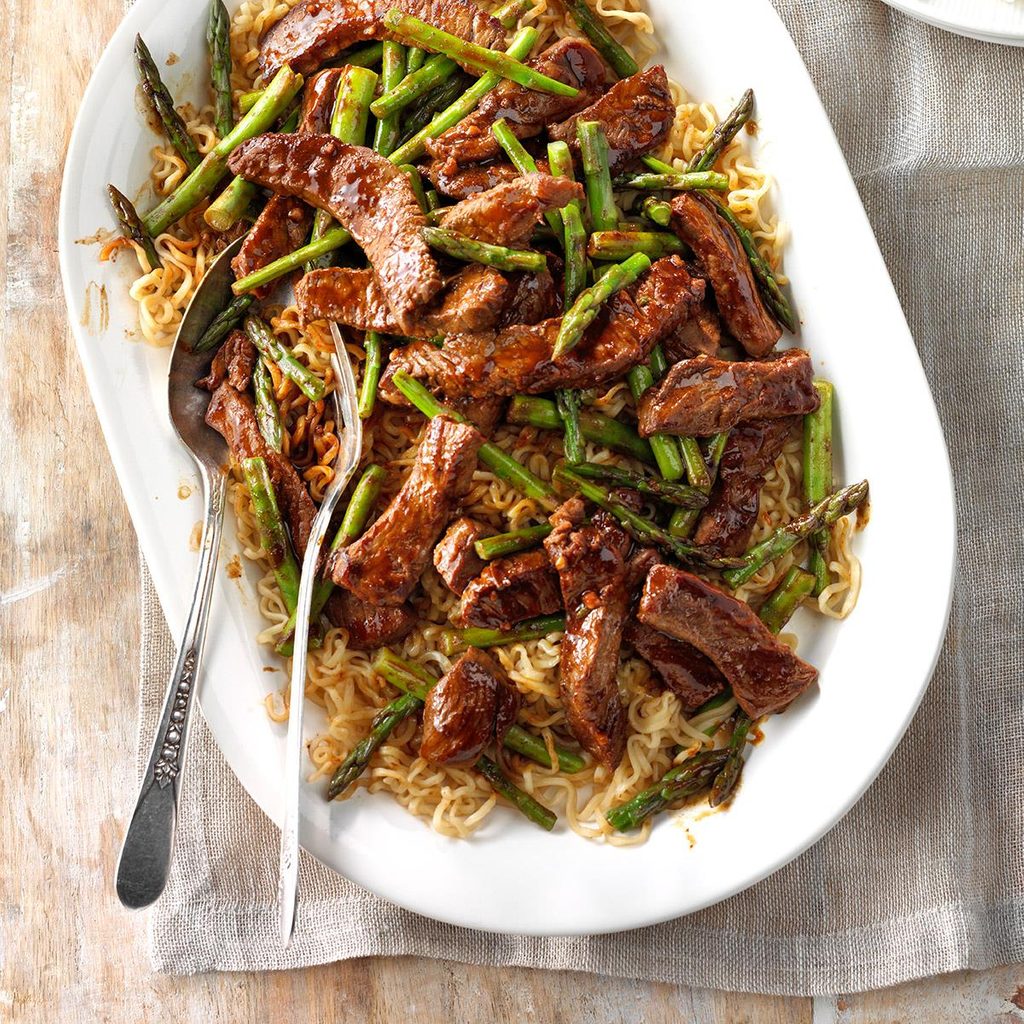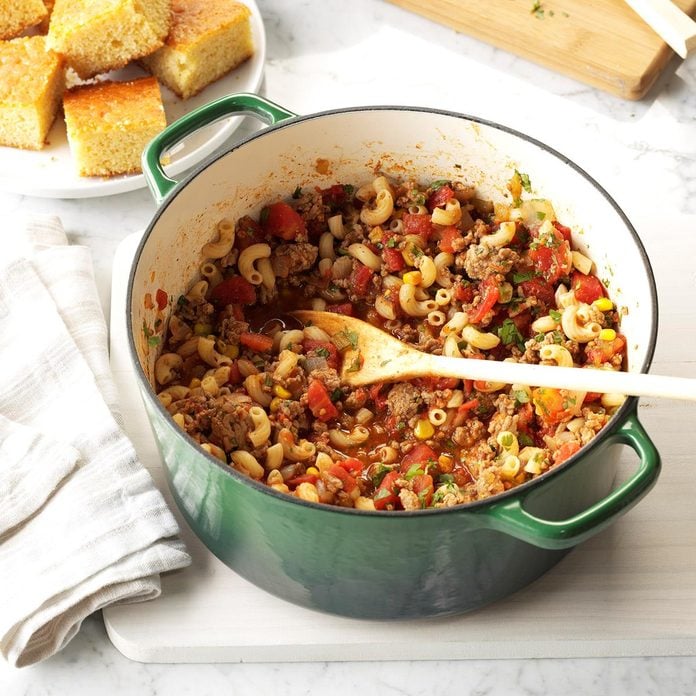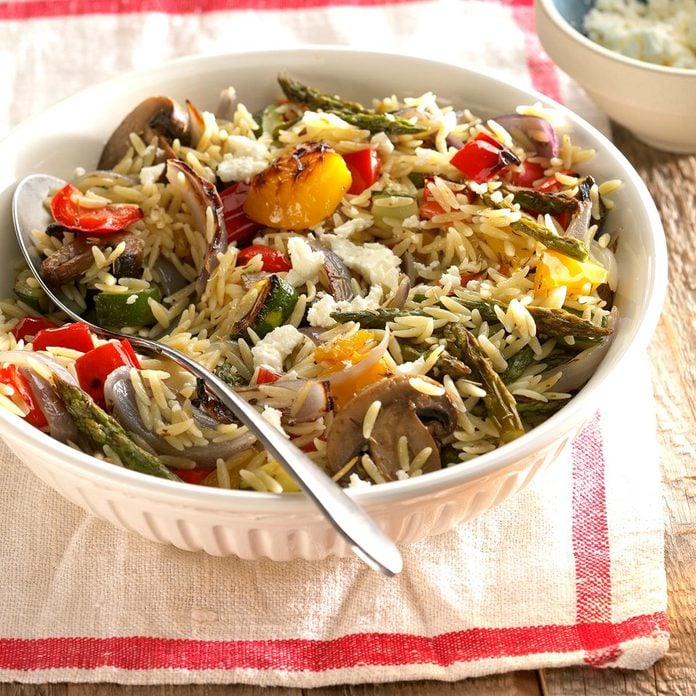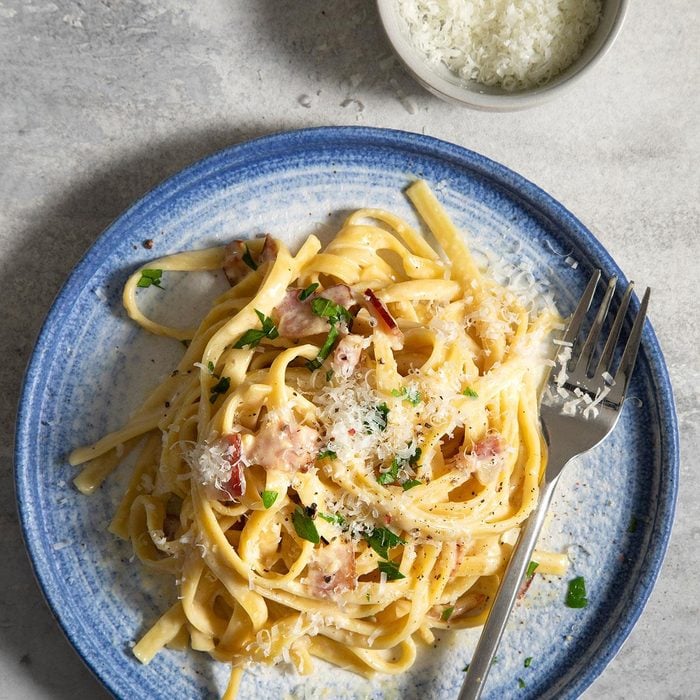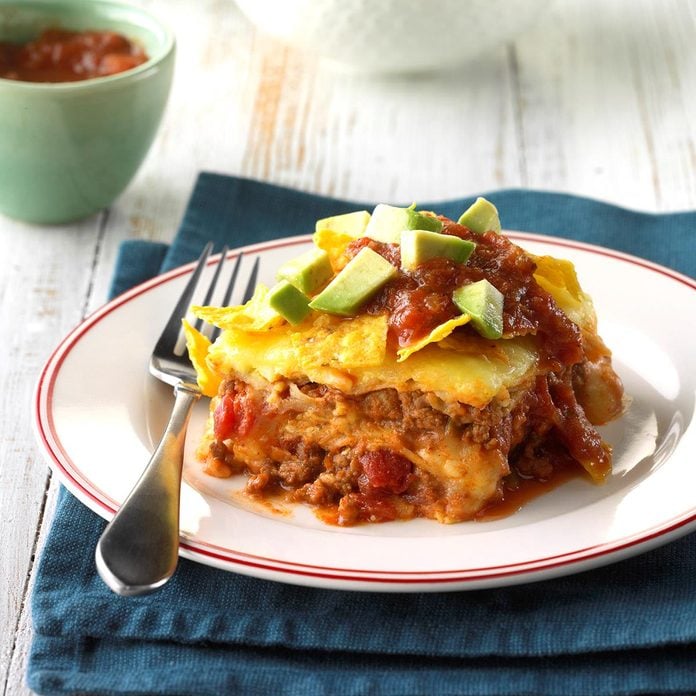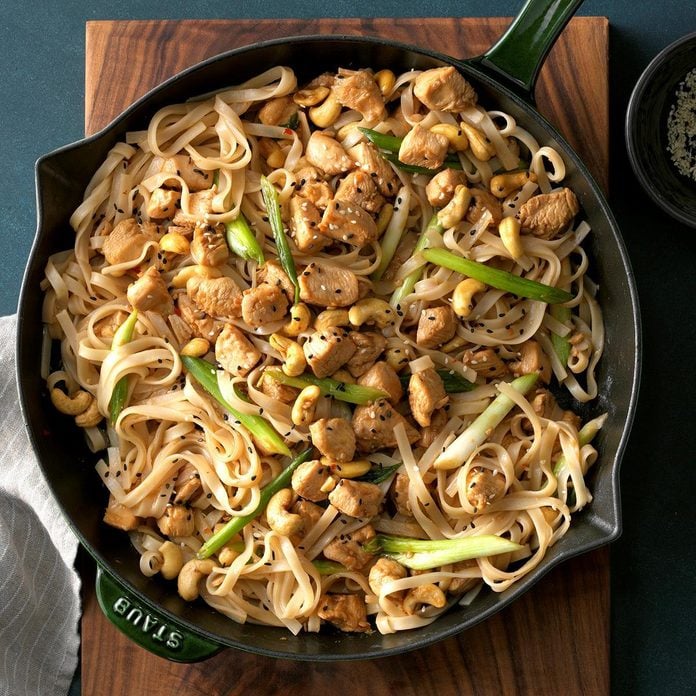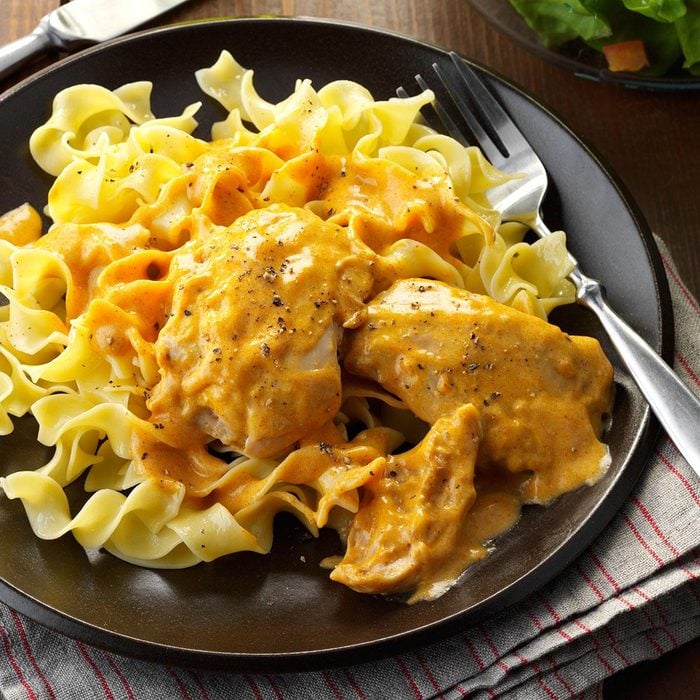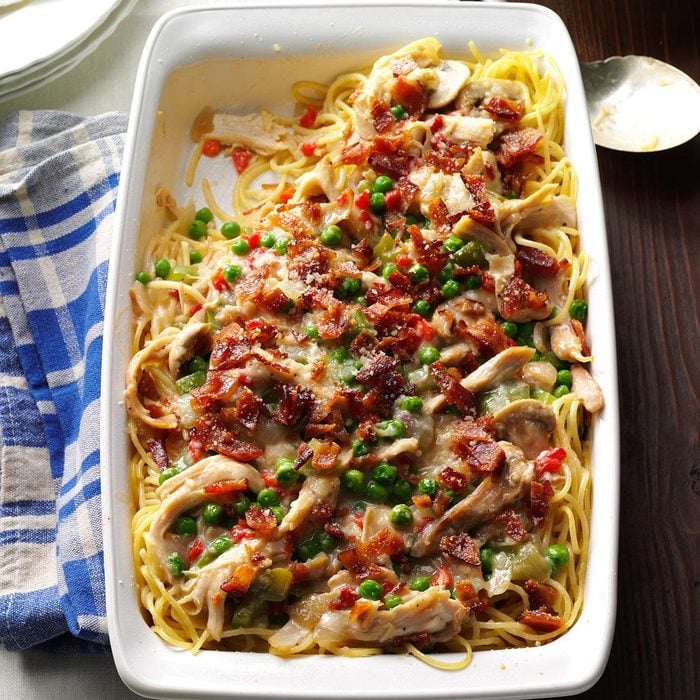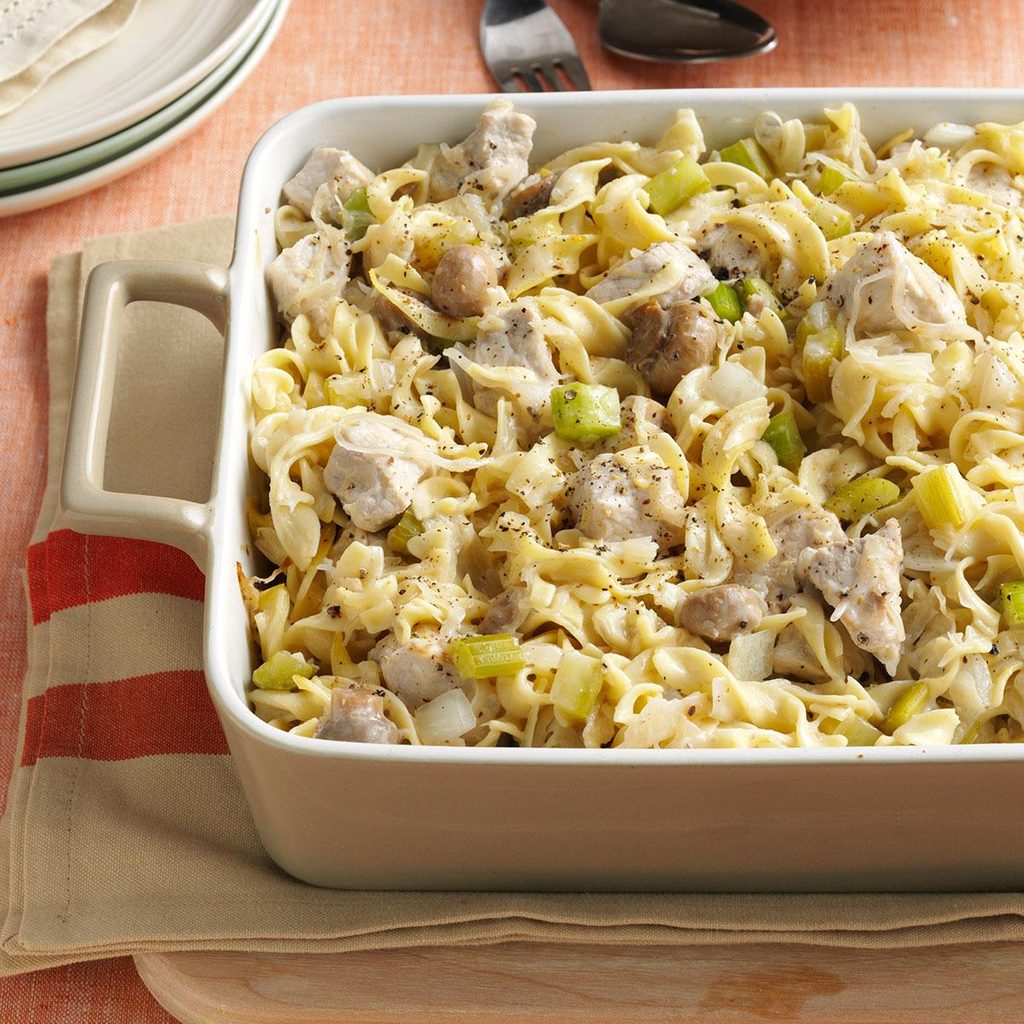Nikki’s Perfect Pastitsio
My mother used to work so hard in the kitchen to make this classic Greek dish, and the results were always well worth her effort. My recipe for pastitsio is easier, a bit lighter and every bit as great as Mom's.—Nikki Tsangaris, Westfield, Indiana
Get Recipe
(Try these other
international recipes!)
Beef Bolognese with LinguineAfter much research, tasting and tweaking, I finally came up with this beef bolognese recipe, based on a dish from an Italian restaurant where I worked. It’s perfect for feeding a house full of guests. —Christine Wendland, Browns Mills, New Jersey
Argentine LasagnaMy family is from Argentina, which has a strong Italian heritage and large cattle ranches. One of our favorite Argentinian recipes is this all-in-one lasagna packed with meat, cheese and veggies. —Sylvia Maenenr, Omaha, Nebraska
Thai Chicken PastaI try to buy fresh chicken when it’s on sale. I cook a big batch in the slow cooker, then cut it up and package it in small amounts suitable for recipes like this. When I want it, I just need to pull it out of the freezer and let it thaw. —Jeni Pittard, Canon, Georgia
Penne alla VodkaThis easy and impressive pasta is always on the menu when my husband and I have new friends over for dinner. Years later, they've asked me to make this Penne alla Vodka recipe again. —Cara Langer, Overland Park, Kansas
Sicilian Meat SaucePeople have told me this is better than the gravy their Sicilian grandmothers used to make. But don’t tell the old generation that! —Emory Doty, Jasper, Georgia
Noodle KugelI make this traditional dish along with other Jewish specialties for an annual Hanukkah/Christmas party with our friends. -Lauren Kargen, Williamsville, New York
Slow-Cooker Short Rib Ragu over PappardelleAn irresistible sauce gives this beef another dimension of flavor. Nearly any starchy side, such as potatoes or polenta, will work in place of the pasta.
Short ribs are my crowd-pleaser weekend meal for all occasions. —Missy Raho, Morristown, New Jersey
Ramen Noodle Stir-FryThis mildly flavored ramen noodle stir-fry combines tender strips of chicken with vegetables and popular ramen noodles. I came up with this
ramen noodle recipe when I wanted a quick-fix meal for myself. Sometimes I change the vegetables or substitute ground turkey for the chicken. —Dawn Boothe, Lynn Haven, Florida
Greek Shrimp OrzoThis is one of our favorites. It's delicious, satisfying and reheats well. My husband would rather have “the orzo dish” than go out to eat. Serve it with crusty bread and salad. —Molly Seidel, Edgewood, New Mexico
Try pairing this dish with one of these
breads from around the world!
Pressure-Cooker Tuscan Chicken PastaIf you're looking for a quick and easy dinner, this
Tuscan chicken pasta is just the ticket. After the milk and cream cheese are added, the mixture will look liquidy. Just continue to cook and stir and the dish will come together. —Amber Gaines, Colorado Springs, Colorado
Chicken Satay NoodlesThis recipe is so quick and easy. It was given to me by a friend and it tastes just like chicken satay! —Salina Moore, Woodward, Oklahoma
MostaccioliEven though we're not Italian, this rich, cheesy pasta dish is a "family tradition" for holidays and special occasions. I was delighted the first time I tried this mostaccioli recipe—it has all the flavor of lasagna without the work of layering the ingredients. Try it…I'm sure it'll become one of your family's favorites, too! —Nancy Mundhenke, Kinsley, Kansas
Chicken ScampiThis chicken scampi recipe is so delectable that I'm often asked to double it when family members visit over the holidays. I also suggest preparing it with shrimp for a quick convenient alternative that's also delicious. —Janet Lebar, Centennial, Colorado
Southwest Tuna Noodle BakeNone of my co-workers had ever tried tuna noodle casserole, and since we live near the Mexican border, they challenged me to make a Southwest version. After trying the tasty results, everyone wanted the recipe! —Sandra Crane, Las Cruces, New Mexico
Italian Stuffed ShellsA dear friend first brought over this stuffed shells recipe. Now I take it to other friends' homes and to potlucks, because it's always a big hit! —Beverly Austin, Fulton, Missouri
Authentic Pasta CarbonaraI learned on my culinary internship in Tuscany that real Italian cuisine is simpler than you think! This carbonara is quick, simple and delicious, just the way they like it in Italy. —Lauren Brien-Wooster, South Lake Tahoe, California
Vegetarian Pad ThaiThis is a simple pad thai loaded with crisp vegetables and zesty flavor. It’s quick, simple, and fresh-tasting. —Colleen Doucette, Truro, Nova Scotia
Pasta NapolitanaThis is the ultimate meat lovers sauce and is my copycat version of The Cheesecake Factory's pasta. Rich and hearty, with tremendous flavors, this pasta Napolitana will disappear quickly. I always make extra sauce, as it freezes very well. —J
ohn Pittman, Northampton, Pennsylvania
Cauliflower Dill KugelI enjoy cauliflower and kugel, so it made sense to combine the two into one special dish. The ricotta cheese adds a distinctive creaminess and lightness. —Arlene Erlbach, Morton Grove, Illinois
Homemade ManicottiThese tender manicotti are much easier to stuff than the purchased variety. People are always amazed when I say I make my own noodles. My son fixed this recipe for several of his friends, and they were extremely impressed with his cooking skills. —Sue Ann Bunt, Painted Post, New York
Polish CasseroleWhen I first made this dish, my 2-year-old liked it so much that he wanted it for every meal! You can use almost any pasta that will hold the sauce. —Crystal Bruns, Iliff, Colorado
Tofu Chow MeinThis is an easy recipe for a "tofu beginner," as it teaches people how to use it. If you have time, one way to prepare it is to cut the tofu block in half and wrap well in a terry kitchen towel. Let it sit in the fridge for at least an hour to absorb excess water. For a complete meal, serve with Chinese soup and egg rolls! — Autumn SinClaire, Gold Beach, Oregon
Greek Salad RavioliTurn the fresh flavors of a Greek salad into a warm dish for cold winter nights. I like to make a large batch, freeze it, then simply drop ravioli into simmering water for dinner in five minutes! —Carla Mendres, Winnipeg, Manitoba
Slow-Cooker Spaghetti & MeatballsI’ve been cooking for 50 years, and this dish is still one that guests request frequently. It is my No. 1 standby recipe and also makes amazing meatball sandwiches. The sauce works for any
type of pasta. —Jane Whittaker, Pensacola, Florida
Homemade Fettuccine AlfredoThis easy Alfredo sauce is creamy, comforting and coats fettuccine noodles in fine fashion. This recipe is wonderful as is, but sometimes I like to add sliced fresh mushrooms and black olives that have been sautéed in butter and garlic. —Jo Gray, Park City, Montana
Steak & Mushroom StroganoffThis homey recipe of steak and
egg noodles in a creamy sauce is just like what we had at my gran's house when we visited. It's one of my favorite "memory meals," as I call them. —Janelle Shank, Omaha, Nebraska
Slow-Cooker Pasta e FagioliThis chunky soup is good to the last spoonful. It's my go-to recipe because it's so hearty and we all always want more. —Penny Novy, Buffalo Grove, Illinois
Swedish MeatballsMom fixed this Swedish meatball recipe for all sorts of family dinners, potluck suppers and PTA meetings. The scent of browning meat is intoxicating. Add to that the sweet smell of onions caramelizing, and everyone’s mouth starts watering. —Marybeth Mank, Mesquite, Texas
Grecian Pasta & Chicken SkilletWe love a homemade meal at the end of the day. But the prep involved? Not so much. My Greek-inspired pasta is lemony, herby and, thankfully, easy. —Roxanne Chan, Albany, California
Beef Paprikash with Fire-Roasted TomatoesBeef paprikash, a Hungarian dish, makes a marvelous Sunday dinner. We prefer it with kluski egg noodles, or try mashed potatoes. —Gloria Bradley, Naperville, Illinois
The Best Ever LasagnaMy brother, Joe, created this lasagna based on our mom’s recipe. It’s a family favorite at Christmas, thanks to the special ingredients that make it
magnifico. —Stephanie Marchese,
Taste of Home Visual Production Director
Spanish Noodles & Ground BeefBacon adds crunch to this comforting stovetop supper my mom used to make when I was a kid. Now I prepare it for my own family. —Kelli Jones, Perris, California
Noodle PuddingWhenever I bring this creamy dish to gatherings, it always prompts recipe requests. The surprising sweetness comes from apricot nectar, and everyone enjoys the golden buttery topping. —Eileen Meyers, Scott Township, Pennsylvania
Italian Pasta BakeI love to make this pasta bake whenever I need to bring a dish to pass. Fresh tomatoes add a nice touch that's missing from most other meat, pasta and tomato casseroles.—Karla Johnson, East Helena, Montana
Chicken & Egg Noodle CasseroleA friend and her family went through a really difficult time, and I felt so awful for them. Bringing over this chicken noodle casserole was the one thing I could think of to help them out in a tiny way and let them know I was thinking of them. —Lin Krankel, Oxford, Michigan
Thai Pasta with Spicy Peanut SauceWe love how the whole wheat pasta and crisp, raw vegetables blend with the rich and creamy peanut sauce. The addition of fresh lime juice really brightens the flavor of the dish. Some eat it hot, but my husband and I prefer to wait until it's closer to room temperature. —Donna McCallie, Lake Park, Florida
Beef Teriyaki NoodlesAt our house, we love to combine fresh ingredients with a pantry product. This version starts with beef, onions, peppers and mushrooms, since we always have them on hand, but make the dish your own—bring out your inner chef! —Richard Robinson, Park Forest, Illinois
Greek Pasta TossMy husband and I developed this bright pasta dish by tossing in favorite Greek ingredients like olives, feta cheese and sun-dried tomatoes. Try it with shrimp or chicken, too! —Terri Gilson, Calgary, AB
Vegetable Pad ThaiClassic flavors of Thailand abound in this fragrant and flavorful dish featuring peanuts, tofu and noodles. New to tofu? It gives the entree its satisfying protein, for a delicious way to introduce it to your diet. —Sara Landry, Brookline, Massachusetts
Red Clam SauceThis recipe tastes like an Italian restaurant specialty and cooks while you take care of other things. What a marvelous way to jazz up pasta sauce! —JoAnn Brown, Latrobe, Pennsylvania
German Noodle BakeThis is a recipe I serve each year for my holiday open house because everyone looks for it. Store-bought noodles can be substituted, but I prefer
homemade noodles...and so does everyone else. —Kathleen Meineke, Cologne, New Jersey
Italian Three-Cheese MacaroniMy husband is a self-proclaimed mac-and-cheese connoisseur and says that this is his favorite version. The Italian seasoning and tomatoes really complement the pasta and cheeses. —Adriane Mummert, Lancaster, Pennsylvania
Thai Lime Shrimp & NoodlesThe flavors just keep popping in this quick dinner! Use as much lime peel and chili paste as you like. —Teri Rasey, Cadillac, Michigan
Greek Tortellini SkilletLooking to please picky little palates? One tester loved this simple skillet entree so much, she made it at home for her 2-year-old daughter, who said "Mmm!" after every single bite. —Taste of Home Test Kitchen
Easy Chow MeinSome years ago, our daughter welcomed me home from a hospital stay with this Asian dish and a copy of the recipe. Now I freeze leftovers for fast future meals. —Kay Bade, Mitchell, South Dakota
Beef Burgundy Over NoodlesI got this delightful beef burgundy recipe from my sister-in-law many years ago and have used it ever since. Whenever I serve it to guests, they always request this. The tender beef, mushrooms and flavorful sauce are delicious over noodles. —Margaret Welder, Madrid, Iowa
Ricotta Gnocchi with Spinach & GorgonzolaWhen my family comes for a visit, they always ask me to make this unique dish for dinner. Homemade cheesy gnocchi is topped with a rich sauce made with butternut squash, spinach and Gorgonzola.— Brud Holland, Watkins Glen, New York
Shrimp Pasta SaladI adore shrimp, so discovering it in this pasta salad recipe was a real treat for me. The lemon-dill sauce is light and bright. It's one of our favorite
cold pasta salad recipes! —Traci Wynne, Denver, Pennsylvania
Asparagus Beef Lo MeinThis springtime beef lo mein recipe is as easy as it gets. Ramen noodles make it extra fun. —Dottie Wanat, Modesto, California
Southwestern GoulashI had some extra cilantro in the fridge and didn't want to throw it away. Instead, I came up with this delightful and filling family recipe. Everyone just loved it! —Vikki Rebholz, West Chester, Ohio
Roasted Veggie OrzoMy sister inspired this recipe. I added a few more spices, but the concept is hers. It's easy to vary, is a great way to add veggies to your diet and the olive oil is heart healthy. —Jackie Termont, Richmond, Virginia
Fettuccine CarbonaraWhen a man at church found out how much my family likes fettuccine, he shared his Italian grandmother's carbonara recipe with us. I've made it my own over the last 25 years. Grated Parmesan cheese works just as well as Romano. —Kristine Chayes, Smithtown, New York
Texas-Style LasagnaWith its spicy flavor, this dish is a real crowd-pleaser. It's wonderful with side servings of picante sauce, guacamole and tortilla chips.— Effie Gish, Fort Worth, Texas
Cashew Chicken with NoodlesI tried this recipe for chicken with cashew nuts when making freezer meals with some friends. I was smitten! It's quick, easy and so delicious! —Anita Beachy, Bealeton, Virginia
Creamy Chicken Thighs & NoodlesI love recipes that you can just throw into the slow cooker and let it do all the work. This easy chicken dinner is one of my favorites. —Christina Petri, Alexandria, Minnesota
Mom's Chicken TetrazziniRotisserie chicken turns this baked spaghetti into a warm, cozy meal our family craves. If we have leftover turkey, we use that, too. —Jennifer Petrino, Newnan, Georgia
Sauerkraut Hot DishWe often serve this hearty dish at family gatherings, and the men especially seem to enjoy it. My sister gave me the recipe about 15 years ago. It’s been a favorite ever since. The unusual blend of ingredients is a pleasant surprise.
—Nedra Parker, Dunbar, Wisconsin
